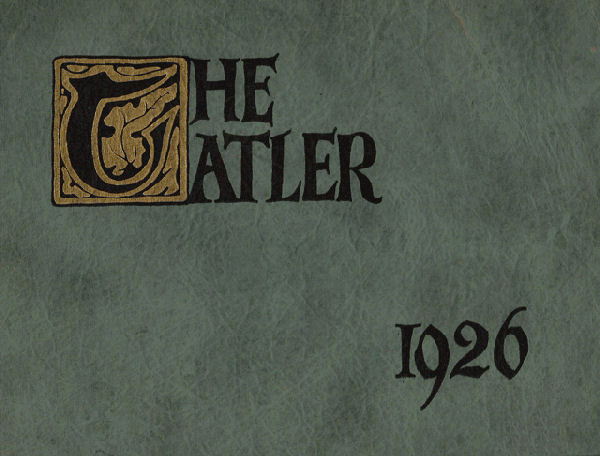
The Project Gutenberg EBook of The 1926 Tatler, by Various This eBook is for the use of anyone anywhere at no cost and with almost no restrictions whatsoever. You may copy it, give it away or re-use it under the terms of the Project Gutenberg License included with this eBook or online at www.gutenberg.org Title: The 1926 Tatler Author: Various Editor: Margaret Louise Newhall Release Date: June 28, 2008 [EBook #25926] Language: English Character set encoding: ISO-8859-1 *** START OF THIS PROJECT GUTENBERG EBOOK THE 1926 TATLER *** Produced by Alicia Williams, Sam W. and the Online Distributed Proofreading Team at https://www.pgdp.net

See the flyleaf signed by students.
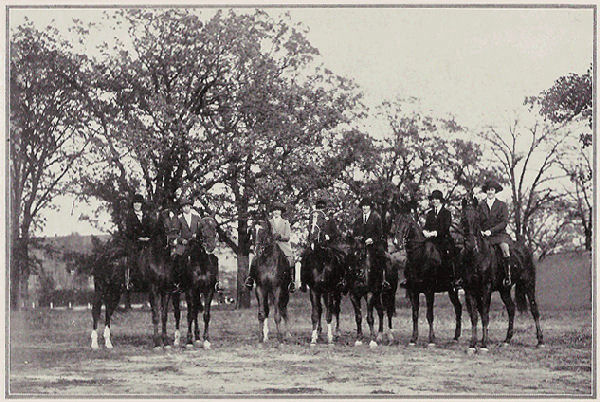
SCHOOL days are joy days; days filled with the pleasures of friendships and the gladness of intimacy, with the satisfaction of work well done and the pride in having done it for one’s school. And we at Northrop School have been blessed with such days from the time of four entering as kindergarteners, up through grammar school and our subsequent joining of the League; on through these last days when, as high school girls, we took a real part in the activities of school life, and felt ourselves to have each one a share, however small, in the great whole, our Alma Mater. And it is to recollection of these joys and to the memory of our school days that we of the senior class wish to dedicate the 1926 Tatler.
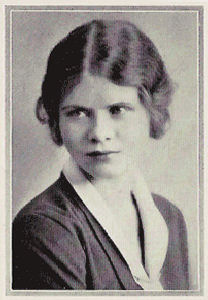 |
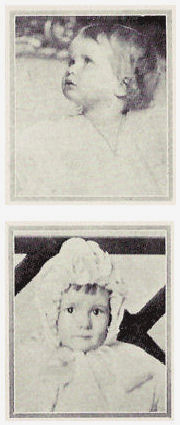 |
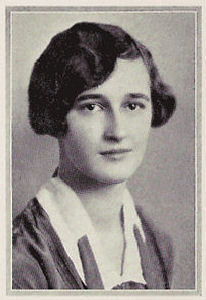 |
| Evelyn McCue Baker | Mary Barber Eaton | |
| President of the Senior Class | President of the League | |
| “She’s as good as she is fair” | “She who feels nobly, acts nobly” |
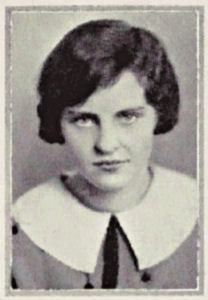 |
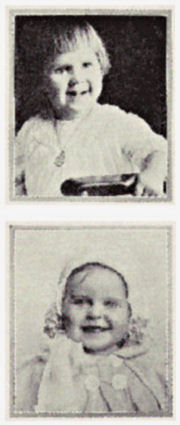 |
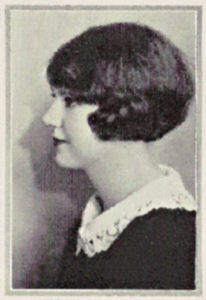 |
| Margaret Louise Newhall | Virginia Josephine Leffingwell | |
| Editor of 1926 Tatler | Vice-President of League | |
| “Young and yet so wise” | “The soft, bright curl of her hair and lash And the glance of her sparkling eye I saw, and knew she was out for a dash As her steed went prancing by.” |
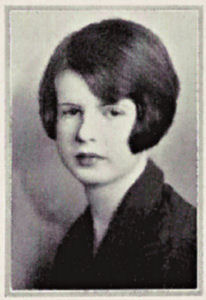 |
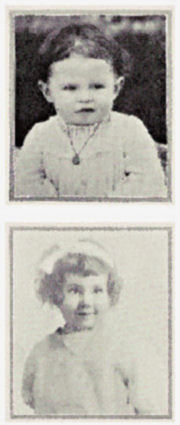 |
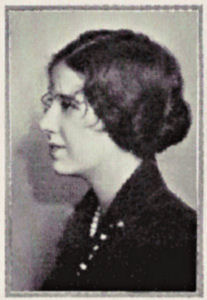 |
| Bernice Alyne Bechtol | Mary Elizabeth Brackett | |
| “Her hair is not more sunny than her heart” | “She has a natural wise sincerity and a merry happiness” |
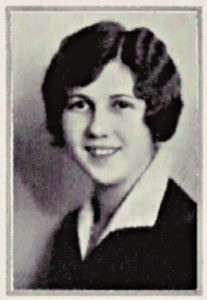 |
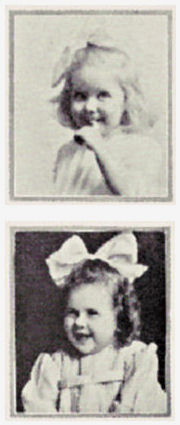 |
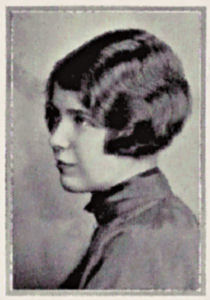 |
| Esther Mabel Davis | Lydia Mortimer Forest | |
| “The glass of fashion and the mold of form” | “She giggles when she’s happy, and one might even say That when there is no reason, she giggles anyway” |
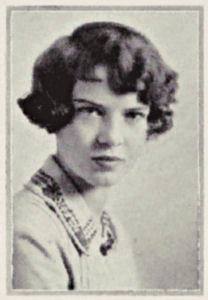 |
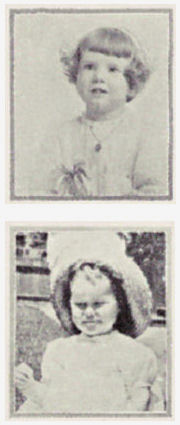 |
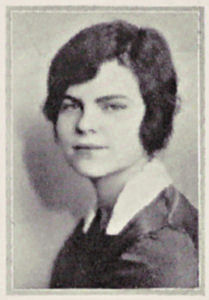 |
| Marion Josephine Hume | Ann Wilder Jewett | |
| “For she’s a jolly good fellow, Her school mates all declare, She’s out for all athletics, There’s nothing she won’t dare” |
“True worth cannot be concealed” |
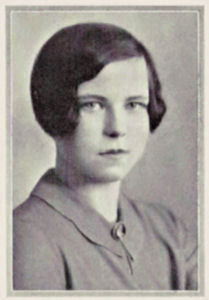 |
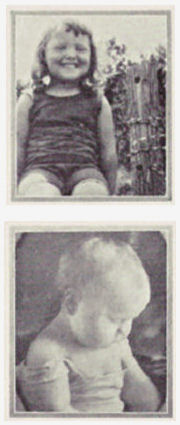 |
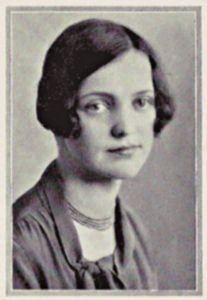 |
| Beatrice Myrtice Joslin | Marion Harriet McDonald | |
| “There is mischief in that woman” | “Happy I am, from care I’m free; Why aren’t all the rest contented like me?” |
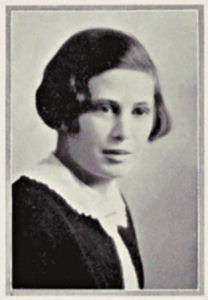 |
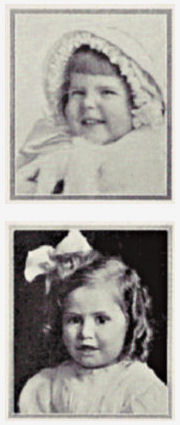 |
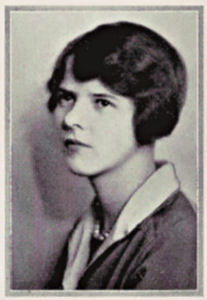 |
| Josephine Reinhart | Marion Jean Savage | |
| “Nothing is impossible to a willing heart” | “The will can do If the soul but dares” |
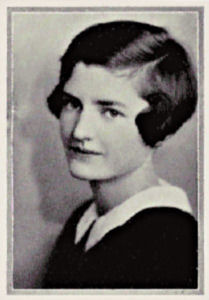
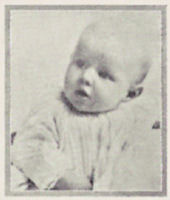
Nancy Morris Stevenson
“A perfect woman, nobly planned,
To warn, to comfort, to command”
A SHIVER ran down my back as the last chords of the Ivy Song were played. It was actually a reality—our dream had come true for we were at last garbed in those precious white robes for which we had been striving for four years. Memories of these years rushed over me. How burdened we were with our importance in being Freshmen; Seniors seemed very old and distant. Suddenly we slipped from cock robins to conscientious Sophomores. By this time rumors were heard of a financial problem that we, as Juniors, must meet. Immediately we began to save all our pennies in order to startle the Faculty and the Seniors of 1925 with a luxurious Junior-Senior ball. So our Sophomore year closed with many peeks into the class treasury.
Dancing, fortune telling, freaks, and so on, came to our rescue in preparation for the J. S. We Juniors, as financiers, staged a Junior carnival—and it was successful.
May the twenty-ninth, in the year of our Lord, one thousand-nine hundred and twenty-five, was the red letter day of our Junior year. Our hopes, not our fears, were realized. Gayly we danced to “Tea for Two” in the green and white decked ballroom (alias the dining room) and promenaded in a garden in Japan, otherwise the roof garden. Sadly—ah, yes—the music hesitated and then ceased—as we unitedly sighed, perhaps with relief, perhaps with weariness. Who knows? Our Herculean task had passed, and our eyes were turned to the magnetic red ties. Honored beyond recognition we were the first to abide in the new Senior room, south-west parallel room 40, on the third floor. June quickly slipped near and we fixed our hopes and ambitions on the now approaching goal, graduation.

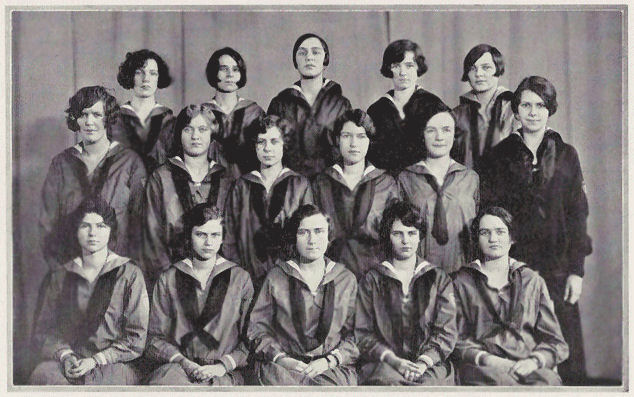
Top Row—Dorothy Sweet, Barbara Bailey, Shirley Woodward, Betty Smith, Mary Louise Griffin
Middle Row—Polly Sweet, Virginia Little, Louise Gorham, Betty Fowler, Mabel Reeves, Grace Helen Stuart
Front Row—Janet Marrison, Frances Baker, Betty Long, Anne Healy, Charlotte Williams
Jane Thompson

WE worked feverishly and hoped that there would be no more disputes concerning the chairs. Some thought the ones from the dining room ought to be used; others thought not. The chairs were brought down and then taken back with much strife along the way. Would anyone want to play bridge? We wondered. Would anyone bring cards to play bridge with? We wondered again. The fact that wax was being applied to the floor caused a good deal of worry, for we were afraid we would fall and break our necks if too much was put on. However, even in that predicament, we were determined to be gracious and smiling. Did everyone know that all the autumn boughs in blue and silver were tied on with red string? We fervently hoped they didn’t, for we were in no condition to do anything about it if they did. Thus our thoughts ran as we slammed down tables, tied on table cloths, and practised our Spanish dance in uniforms and low heeled shoes. At five-thirty we went home, thankful that we didn’t have to wash the windows and clean up the furnace room.
Much credit must be given to those few guests who realized that the gym was supposed to represent a cabaret. We greatly appreciate their penetration. They perhaps didn’t know that fortune-telling and fishing for tin automobiles in the telephone booth were a part of the procedure at a cabaret dance. But if they didn’t know these things, they had much to learn, for that’s what they did at our party and who were we to spurn their filthy lucre? They also danced and ate heartily of the ice cream and cake we served. Many thought the popcorn balls were a holdup, but they refrained from throwing them at us when we asked ten cents.
An attempt was made at amusement when we gave two dances; one with castanets and tambourines and much swirling and swooping; another with Spanish shawls draped on us. This latter one was more or less of a failure, for we couldn’t seem to get into step when we did it a second time. The audience, however, applauded, regardless of the fact, and didn’t see that the dance was any worse than it had been the first time. About eleven-thirty it was gently hinted that the time had come for the party to break up. We went on aching feet, hoping that since the party had been a success financially, the guests were not making too many derogatory remarks about it as a social function.
Dawn broke, and blushed to see the sight at Northrop School: packs of cards scattered in fifty-two different places, tables every which way, covers off, cake and popcorn balls scattered liberally on the floor. A few of us came to clean up, and cleaned with many yawns. After a few hours the gym began to take on its natural air of bleakness, and we left it to the tender mercies of Clyde and Mullen, hoping that the Junior-Senior would be a good one.
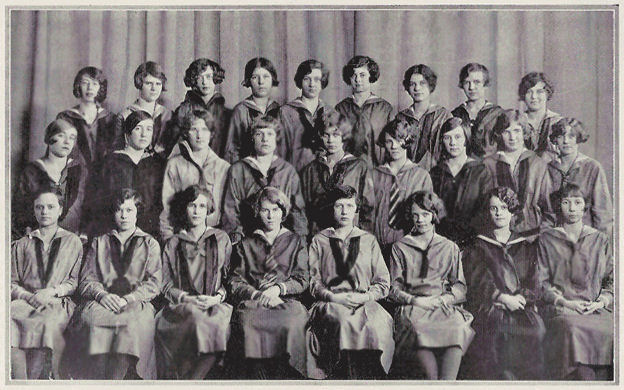
Top Row—Dorothy Stevens, Louise Jewett, Ethel Conary, Jean Crocker, Elizabeth Dodge, Kate Velie, Elizabeth Jewett, Jane Bartley, Anna Margaret Thresher
Middle Row—Dorothy Owens, Nita Weinrebe, Helen Dietz, Jane Davenport, Gloria Congdon, Martha Jean Maughan, Priscilla Brown, Florence Roberts, Eylin Seeley
Front Row—Jane Strong, Mayme Wynne Peppard, Eugenia Bovey, Mary Louise Sudduth, Eleanor de Laittre, Emily Knoblaugh, Elizabeth Pray, Maude Benjamin
Jane Woodward

Seven Shekels in St. Paul Published once in a while
The other day several members of the Sophomore class visited the studios of the famous Mesdames Dodginsky and DeBartley, where they were told their secret ambitions; and by special permission we have been allowed to print them. It appears that Annah Margaret Thresher would like to swim the English Channel. Jean Crocker longs to be a Professor of Music at Oxford, while Florence Roberts would receive all possible degrees at Columbia. Others seem to desire athletic professions. Helen Dietz would like to be the Football Coach at the “U,” Jane Woodward to be the World’s Greatest Lightweight Forward, and Kate Velie to be on the Olympic Sprinting Team. Mayme Wynne has a morbid desire to be a designer of Curious Coiffures in Paris.
By E. B.
The Sophomores suggest a soaking spring if the snow smelts. If it rains sufficiently to suit Miss Svenddahl, they forecast dancing in the Gym. The spring days will be either cloudy, partly cloudy, or clear. It will rain dogs and cats or hail taxicabs, although we may have snow, a tornado, a cyclone, a blizzard, a squall, a typhoon, a tidal wave, or a forest fire.
Last Friday evening the Sophomore Select Sewing Society met at the home of Miss Jane Bartley. A pleasant time was had by all, making rackets and nightcaps for the poor. Refreshments were served.
 BRAIN TICKLER
BRAIN TICKLER 
One of these fleas has been magnified 439 times, the other 438½ times. Which was originally the larger? Take 39 seconds in which to do this.
Question: Dear Doc: What can be done to keep up one’s hair when it is not entirely grown out?—A. M. T. B. D. B. I.
Answer: Cut it off, my dears.
Question: Dear Doc: What can be done for eye-strain caused by drawing maps of the Aegean Sea?—Sophomore Class.
Answer: Don’t do ’em. You will flunk anyway.
Take my three minute course and learn to study successfully. Astound your teachers in any way. See me about it.—J. Crocker.
Learn the art of putting up your hair in two minutes between bells. Don’t be late for your classes. Follow my example. Easy lessons. Apply to B. Dodge.
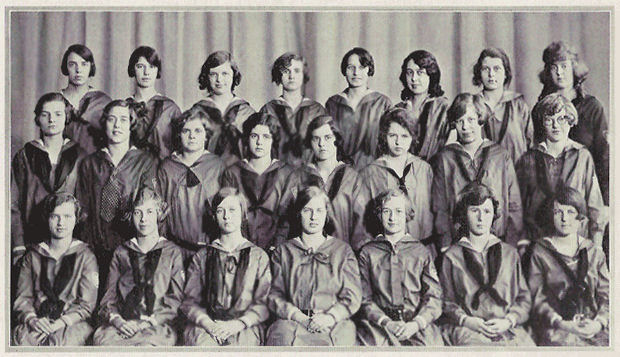
Top Row—Jane Robinson, Martha Eurich, Mary Elizabeth Case, Catherine Colwell, Caroline Doerr, Donna McCabe, Nancy Adair Van Slyke, Catherine Moroney
Middle Row—Edna Louise Smith, Margaret Maroney, Victoria Mercer, Mary Morison, Jean Adair Willard, Virginia Lee Bechtol, Elizabeth Heegaard, Mary Atkinson
Front Row—Alice Tenney, Ann Beckwith, Carol Hoidale, Helen Tuttle, Marion Wood, Beatrice Wells, Mildred O’Brien

(Minneapolis Morning Tribune, June 21, 1932)
The giant airship Coolidge was downed last night in a hurricane on the Atlantic. A terrific wind arose, which broke one of the huge wings. The ship dropped abruptly, and though the captain fired distress signals, nothing could possibly have saved the passengers but the timely arrival of the Admiral Sims, a destroyer, captained by Helen Tuttle, and the ship, The Roosevelt, captained by Caroline Doerr. The two crews worked feverishly, and in less than an hour everyone was off the sinking ship. Miss Tuttle and Miss Doerr were the heroines of the hour, keeping their heads and directing their crews with a coolness equal to any man’s. Several Minneapolis people were on board. Among them were Miss Carol Hoidale, famous sportswoman, who was going to England to be in the Leicestershire horse show; Miss Marion Wood, accomplished pianist; and Miss Elizabeth Heegard, a well-known actress. Miss Doerr, Miss Tuttle, and these three ladies were classmates at Northrop Collegiate School and graduated in 1929.
Miss Nancy Van Slyke and Miss Mary Morison are capturing all the tennis titles. Recently at the tournament at Nice the two Americans defeated Mlle. Isabelle Lenglen, daughter of the famous Suzanne, and Mlle. Pavol, winning both sets, 6-3, 6-0. This gives them the world’s doubles championship.
Last night Miss Beatrice Wells was proclaimed world’s amateur champion fancy skater at the St. Moritz artificial rink.
Miss Jane Robinson and Miss Alice Tenny, the young American athletes, are doing well in the Olympics. Miss Robinson has set a new mark for high jumping. Miss Tenny has shattered all previous breaststroke records.
“Dee,” or Donna McCabe, won the Sanford cup yesterday with her Packard straight eight. She lowered her previous record by several minutes. The distinguished monogram on the hood was designed by Mary E. Atkinson.
Miss Martha Eurich and Miss Margaret Maroney, famous artists, returned today from Mars, where they went to make sketches of an improved type of building that has airplane parking space on the roof. They were sent by Miss Mary E. Case, president of the Animal Rescue League, who contemplates building a new sky-scraper for animals.
Miss Catherine R. Mount, the well-known New York designer, says trains are coming back. She bases her claims on the present length of skirts.
“The Same Old Story,” written by Miss Anne Beckwith, is a delightful book. The plot is very new and the book is very original. It is pleasantly illustrated by Miss Catherine Colwell, who is so famous for her drawings, and is dedicated in verse by Virginia Lee Bechtol to Miss Cordelia Lockwood.
Miss Edna Lou Smith will be the soloist for tomorrow’s concert, that is if she doesn’t disappear in the meantime.
Miss Mildred O’Brian will make her debut tomorrow at a tea given by her mother. Miss O’Brian will wear a corsage bouquet given by her mother, the first part of the afternoon. After that she will wear the corsages given by her admirers, a minute each.
Judge Victoria Mercer sentences Hard Boiled Egg for life.
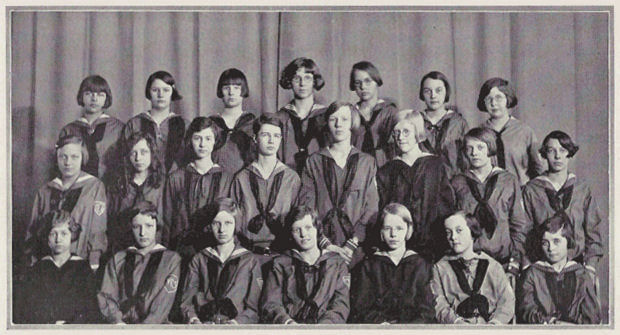
Top Row—Muriel Miner, Frances Lee, Betty Stroud, Harriet Kemp, Lorraine Stuart, Alice Wright, Betty Bean
Middle Row—Betty Strout, Grayce Conary, Mary Elizabeth Ricker, Esther Hazlett, Mary Elizabeth Thrall, Inez Colcord, Edna Nagell, Ruth de Vienne
Front Row—Marian Murray, Marjorie Osgood, Virginia Cook, Eleanor Bellows, Anne Winton, Louise Partridge, Miriam Powell
Mary Eleanor Best, Ruth Alberta Clark, Aileen Stimson

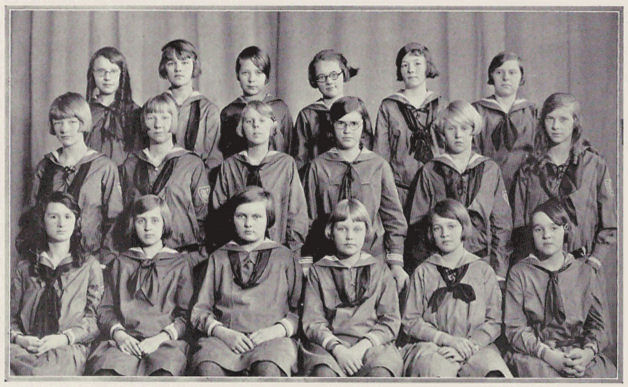
Top Row—Katharine Simonton, Barbara Newman, Betty Goldsborough, Marjorie Williams, Louisa Hineline, Betty Miller
Middle Row—Laura Van Nest, Alice Benjamin, Pauline Brooks, Catherine Wagner, Catherine Piper, Ann Lee
Front Row—Betty Thomson, Elizabeth Junkin, Jane Helm, Virginia Helm, Peggy Gillette, Emily Douglas

Early in the fall the sevenths and eighths had a number of baseball games. Although the sevenths tried very hard, they were always defeated. However, spring is coming, and they may have better luck.
In midwinter when games are indoors, captain ball is the popular sport. The two classes always play two games. In the first one the sevenths were badly beaten, but in the second they came close to victory with a score of 3 to 2.
The winter outdoor fun is on a bumpy, crooked hill back of school used for sliding. Down it goes a continuous stream of sleds, toboggans, and skis. Sometimes an overloaded sled drops a passenger on the way, and sometimes a load lands upside down in a drift, but it’s all part of the fun.
At the beginning of school the seventh form were guests of the eighth form at the opening League party. We danced a great deal, and we laughed at the Wild West show and the autoride of by-gone days. Then we climbed to the top floor for refreshments and more laughing.
On the eleventh of February to return the courtesy, we invited the eighths to a valentine party. After decorating our guests with gay caps, we danced for a while. The event of the day, however, was the valentine boxes. There were three fat ones stuffed with valentines for us all. By the time we had exclaimed over them, we were ready to have refreshments. Cheers of appreciation ended the party.
This year we have been visited by both a princess and a duke. The princess came from Damascus and gave us an ancient story of her city—the story of Naaman the Leper. The duke, who was from France, showed us pictures of beautiful old French buildings, which he is trying to keep from being destroyed.
Early in March our own class took part in a chapel program by demonstrating some lessons in musical appreciation.
Piping merrily William the Piper floated down the meadow Brooks seated at the Helm of his boat. Being a New-man in this country he stopped to ask his way of a Miller. The miller directed him across the Lee to a little town called Goldsborough. There he stopped at the inn of the Van Nest. After a good sleep, a shave with his Gillette, and a hearty meal of Thomson’s baked beans and Wagner’s canned Pease, he was much refreshed.
The next morning he continued his wanderings, but unwittingly he trespassed on the land of a farmer named Hineline, who threatened to take him to the village of Simonton and throw him and his Junk-in jail. Finally he made his peace, but he had to leave his boat behind.
“However, I’m not so unlucky,” said he, “for I have stout Douglas shoes to tramp in, and my faithful dog, Benjamin, to bear me company.”
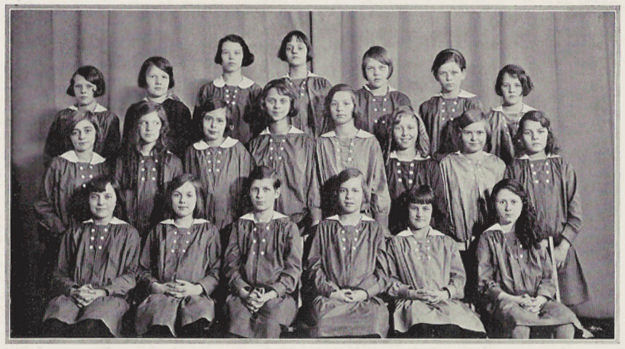
Top Row—Mary Louise Parker, Miriam Lucker, Isabel McLaughlin, Mary Rogers, Betty Short, Janet Bulkley, Jane Fansler
Middle Row—Rosemarie Gregory, Carolyn Belcher, Sally Louise Bell, Grace Ann Campbell, Barbara Bagley, Ella Sturgis Pillsbury, Marie Jaffrey, Elizabeth Mapes
Front Row—Betty Lou Burrows, Charlotte Driscoll, Gretchen Hauschild, Helen Beckwith, Eleanor Smith, Peggy Thomson
Phyllis Foulstone
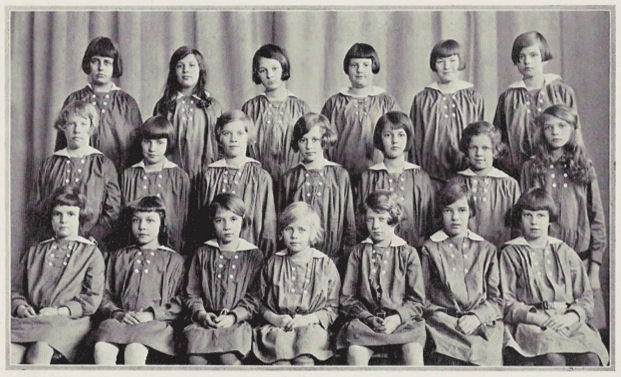
Top Row—Mary Ann Kelly, Anne Dalrymple, Mary Dodge, Barbara Healy, Harriet Hineline, Anne McGill
Middle Row—Barbara Anson, Jane Arnold, Mary Thayer, Mary Foster, Marian Carlson, Edith Rizer, Edith McKnight
Front Row—Betty Jane Jewett, Geraldine Hudson, Ione Kuechle, Virginia Baker, Deborah Anson, Louise Walker, Catherine Gilman
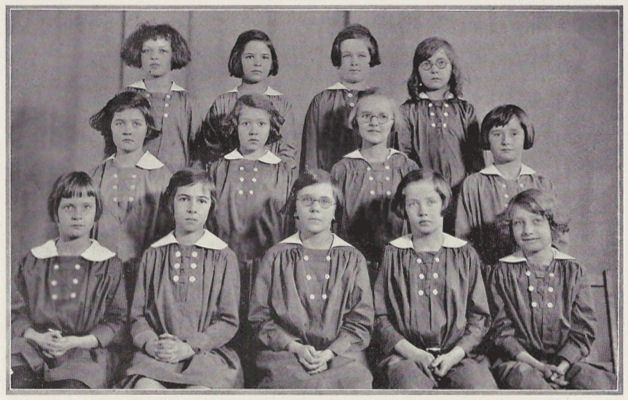
Top Row—Martha Miller, Martha Bagley, Mary Malcolmson, Patty Greenman
Middle Row—Susan Wheelock, Patricia Dalrymple, Helen Louise Hayden, Nanette Harrison
Front Row—Mary Partridge, Olivia Carpenter, Katherine Boynton, Anne Morrison, Dolly Conary
Margaret Partridge, Frances Ward
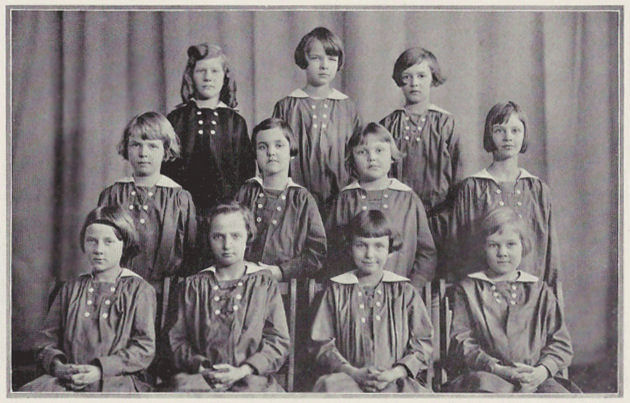
Top Row—Elizabeth Lucker, Sally Ross Dinsmore, Joan Parker
Middle Row—Rhoda Belcher, Penelope Paulson, Harriet Helm, Ottilie Tusler
Front Row—Elizabeth Williams, Susan Snyder, Mary Lou Pickett, Anne PerLee
Charlotte Buckley
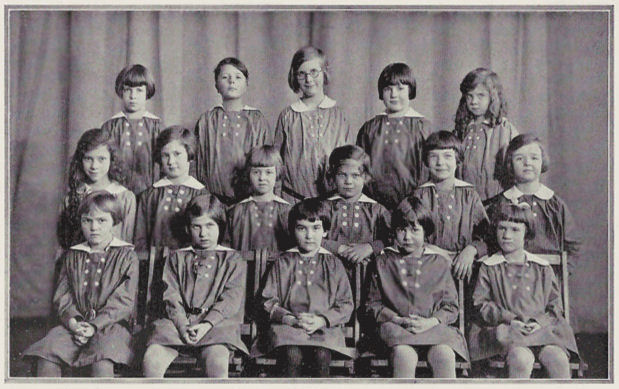
Top Row—Mary Anna Nash, Nancy Rogers, Katherine Dain, Blanche Rough, Betty Tuttle
Middle Row—Betty Lee, Elizabeth Hedback, Elizabeth Ann Eggleston, Ruth Rizer, Jane Loughland, Katharine Rand
Front Row—Janey Lou Harvey, Katherine Warner, Donna Jane Weinrebe, Elizabeth Booraem, Margie Ireys
Barbara Brooks, Helen Jane Eggan
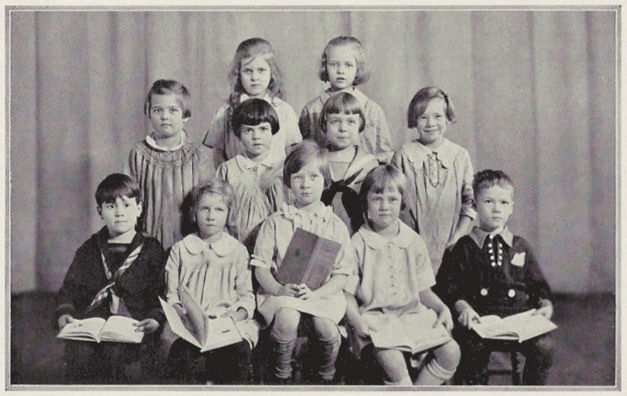
Top Row—Melissa Lindsey, Dorothea Lindsey
Middle Row—Mary Ann Fulton, Laura Booraem, Carolyn Cogdell, Peggy Carpenter
Front Row—Bobby Thompson, Martha Pattridge, Betty King, Jane Pillsbury, Calder Bressler
Whitney Burton, Betty June Tupper, Jean Bell
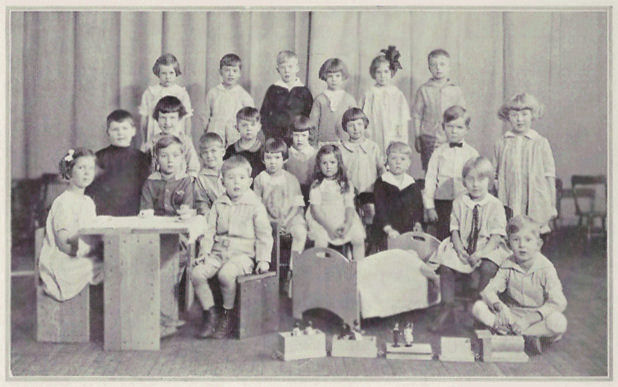
Top Row—Jean Clifford, Archie Walker, Jimmie Wyman, Mary Jane Van Campen, Sally Jones, Vincent Carpenter
Middle Row—Morris Hallowell, Janet Sandy, Ogden Confer, Beatrice Devaney, Ann Carpenter, Frederick Jahn, Barbara Taylor
Front Row—Phyllis Beckwith, Yale Sumley, David Warner, Jamie Doerr, Elizabeth Hobbs, Gloria Hays, Lindley Burton, Frances Mapes, Henry Doerr
Sheldon Brooks, Billy Johns, Betty Webster, Barbara Hill, Patty Rogers, Emmy Lou Lucker, George Pillsbury, Jane Pillsbury

Smith College,
Northampton,
Massachusetts,
February 23, 1926.
Dear Janet:
When I received your letter asking me to tell Northrop what her alumnae at Smith have been doing this year, I had a sudden sinking sensation, since I felt that the achievements accomplished by some of us have not been startling. However, upon digging for evidence, I have discovered that Northrop need not feel ashamed of us after all.
Dorothy Wilson sings in the Junior choir, is a member of the Smith College glee club, and of the Oriental club—one which is connected with the Bible department—and has been chosen business manager of the Smith College Handbook—“Freshman Bible”—for the class of 1930.
“Pete” McCarthy, also a Junior, who vehemently claimed that she had nothing to tell me about herself, I discover is fire captain of her house, a member of the French club, and chairman of the spring dance committee.
On Washington’s Birthday, at the annual rally day performance, Mary Truesdell and Lorraine Long, dressed as sailors, with the accompaniment of the Mandolin Club, clogged for us in multifarious rhythms, ways, and manners—or however one does clog—to the astonishment of all of us, who never before dreamed that professional talent actually existed in Northampton.
Elizabeth Carpenter is president of her house. As for the rest of us, Lucy Winton, Eleanor Cook, and me, all I can venture to say—and they agree with me—is that, like the proverbial green freshman, we have been plodding along at studies occasionally, and at all other times we have been eating, sleeping, or amusing ourselves to the nth degree.
I can’t wait to see the new Tatler to find out what you have been doing this year.
Please give my love to everyone.
Very sincerely,
Peg Williams
South Hadley,
Massachusetts,
February 18, 1926.
Dear Margaret Louise:
If I should attempt to tell you everything we are doing here now, I’m afraid that I should go far past the limits of my little column, for our occupations are so multitudinous and varied that there is hardly an end to them.
Right now, notwithstanding the ever present pursuit of the academic, the whole college is having the most glorious time hiking over the countryside on snowshoes, risking its dignity and perhaps its neck in attempting the ski jump on Pageant Field, and “hooking” rides with the small village boys on their bob sleds down the long hill on College Street. South Hadley is such a tiny town, anyway, that it is just like living in the country with lovely mountains all around.
By now Mount Tom and Mount Holyoke are quite like old friends, for most of us had a personal interview with one or the other of them when we hiked one of the ranges last fall on Mountain Day. Mountain Day, by the way, was a red letter day, for the Freshmen particularly. [Pg 34] It was one of those gorgeous blue October days when we could hardly stand the thought of having to be inside, and, almost like a gift from Heaven, Miss Woolley unexpectedly announced in morning chapel that she would leave it to the students to vote whether they would have their holiday then, with its incomplete arrangements, or two days later when it was scheduled, with beautifully laid plans but with possible showers. The girls were simply bursting with excitement by that time, and the vote was carried unanimously. Not one class in prospect for that day, but just a chance to start out with a lunch on your back to “parts unknown”—oh, it was wonderful!
Another big part of our college social life here in the fall and spring is college songs and class serenades. During September and October we had one out by the “College Steps” once a week. I shall never forget the first time we gathered under a full moon, about nine o’clock, and our senior song leader started us off by having us sing all the songs we knew about the moon, with the singing of parts much encouraged! Even if the harmony was a little doubtful in spots, taken as a whole the result was “perfectly heavenly”—to one enthusiastic Freshman. Then a few weeks later the Freshmen were called to their windows one evening to hear “Sisters, sisters, we sing to you,” and looking down, we saw the whole Junior class assembled underneath the dormitory windows. Then in due time our turn came to “surprise them,” but it wasn’t, evidently, kept a “deep and dark” secret as we had hoped, for at the end of the first song we were literally showered with candy kisses hurled down from above.
These are just a few of the kinds of things we do outside our academic work; not to mention the picnic breakfasts at “Paradise” in the warm weather, sleigh rides or hikes to Old Hadley, a quaint old town near here, Winter Carnival, or all the excitement that comes with Junior Prom time. Then, you may be sure, the “little sisters” are pressed into service!
What I think, however, makes Mount Holyoke mean what it does to us is something that is almost impossible to describe, but something that is just as real as any phase of our life here—and that is the college atmosphere. It is created, in part, by Miss Woolley’s wonderful chapel services, in part by the sheer beauty of the country in which we live, and, lastly, by the fine spirit of the girls themselves, the college community.
Very sincerely,
Doris Douglas, ’25.
To the Editor of the 1926 Tatler:
We who once formed a goodly part of Northrop’s illustrious student body, but who now attend Vassar College, send our heartiest and most affectionate greetings, to the pupils, the faculty, the trustees, and Miss Carse!
In the first part of the year, when those of us who are Freshmen were busying ourselves with getting adjusted to our new environment, new studies, and new acquaintances, we had no time to reflect on our past activities. But now that we have become acclimated, we take great joy in remembering our years spent at Northrop, and realize, more and more, all that she did for us. We owe our present life and opportunities to Northrop’s splendid teaching and background. The Northrop League gave us a moral background which we shall never lose. Our companionship with each other gave us friendships which can never be lost, even though we may be separated.
Northrop Alumnae who are Sophomores and the five who are holding up the honor of Vassar’s class of ’26, still feel Northrop’s influence very strongly, and are forever singing her praises. They feel that the training in concentration and in well-divided time received at Northrop has proved invaluable throughout their college course.
The large number of us here at Vassar, set aside as “Northrop girls” feel that we have a great responsibility resting on us. We have a standard to live up to, a standard caused by the good name sent out into the world by Northrop. May we live up to that name, may we carry on the standard of Northrop School.
| OFFICERS OF THE LEAGUE | |
| Mary Eaton | President |
| Virginia Leffingwell | Vice-President |
| Barbara Bailey | Treasurer |
| Florence Isabel Roberts | Secretary |
| CHAIRMEN OF STANDING COMMITTEES | |
| Marion Hume | Athletics |
| Margaret Louise Newhall | Publication |
| Beatrice Joslin | Entertainment |
| CLASS PRESIDENTS | |
| Evelyn Baker | Form XII |
| Betty Long | Form XI |
| Mary Louise Sudduth | Form X |
| Helen Tuttle | Form IX |
| Eleanor Bellows | Form VIII |
| Jane Helm | Form VII |
| ATHLETIC COUNCIL | |
| Marion Hume | Chairman |
| Josephine Reinhart | Form XII |
| Charlotte Williams | |
| Janet Morison | Form XI |
| Betty Jewett | |
| Jane Woodward | Form X |
| Victoria Mercer | |
| Nancy van Slyke | Form IX |
| Ruth de Vienne | Forms VIII and VII |
| TATLER BOARD | |
| Margaret Louise Newhall | Editor |
| Janet Morison | Business Assistant |
| Nancy Stevenson | |
| Marion McDonald | Form XII |
| Virginia Little | Form XI |
| Martha Jean Maughan | Form X |
| Nancy van Slyke | Form IX |
| Anne Winton | Form VIII |
| Pauline Brooks | Form VII |
| FACULTY ADVISERS | |
| Miss Carse | Miss Brown |
| Miss Bagier | Miss Svenddal |
| Miss Sadley | Miss Pease |
| Miss Ferebee | Miss Lockwood |
| Miss McHugh | Mrs. Armstrong |
It hardly seems necessary in this, the sixth year of the League’s existence, to explain its purpose. I think it is sufficient to say that the League is an organization which, under Miss Carse’s sympathetic guidance, has come to control the student activities of the high school and the seventh and the eighth grades. It is true, of course, that the League is governed by its officers, but the League itself is what the large body of the girls make it. The pledge, an expression of its standards, seeks to hold each girl to a high sense of honor, loyalty, and self-improvement. This, briefly, is the purpose. As nearer perfection is reached, in the struggle for this goal, the League gains in power. Thus it is that the League is the result of the effort of every member.
SHOULD any girl of Northrop wish to prepare herself for a position that has to do with the handling of money, I should advise her to begin campaigning by lobbying for the office of Treasurer of the Northrop League. However, the reputation of the detailed work of this office is such that there are few who are ever over-anxious to receive it. This was my feeling at first, but now when I realize how much I already know about making out checks, keeping accounts, and the intricacies of banking, I feel it is all worth while. By Commencement I shouldn’t be surprised if I could fill the important position of messenger in a bank.
The first thing that comes up at the beginning of each year is the collection of the annual League dues, which are two dollars and fifty cents. A total amount of about three hundred dollars was handed in this year. This is put under the “operating fund,” and takes care of all the League expenditures, except those of the Welfare Committee.
There are four departments of student activities drawing from these League dues, athletic, entertainment, and printing and stationery. Also, this year the League voted to back the Tatler board up with one hundred dollars. At the first council meeting of the year a budget is made out for the different committees of the League. This budget is based on the expenditures of that committee for the preceding year. Until nineteen twenty-five, the Welfare work was taken care of by collections running through the year as the various needs arose. This year a new system was adopted, which took care of everything at one time. We foresaw a need of money for the Thanksgiving, Christmas, and Community Funds, for the Near East Relief, and the French Orphans; therefore slips were given to each girl with these different needs listed. She was expected to put an amount after each, which amount she pledged to pay in cash or in deferred payments. So far eight hundred and twelve dollars of the nine hundred and two dollars and thirteen cents pledged has been handed in. This plan is much more systematic, and saves the trouble of conducting so many drives.
All money transactions of classes and committees whether receipts or expenditures go through the hands of the League treasurer. A system of books is maintained. Each class and committee keeps its own accounts. Then the League treasurer has a large cash book in which she also keeps all the receipts and disbursements of the classes and committees. At the end of each month the balances are put in a simplified ledger. It is from this that the monthly and annual reports are made. When a bill is received, it is paid only by the League treasurer after it has been OK’d by the chairman of the committee responsible for it. When money is handed in, a receipt is given to the bearer. At the end of each month the books are balanced and checked with the bank statement. Also the check book is verified with the bank balance.
Although the League treasurer is custodian of the class funds, each class has a treasurer who keeps her own accounts. The classes have their own dues to pay for all their expenditures. At the end of each month, after the class treasurer has balanced her book, it is checked over with the accounts of the League treasurer for that class to see if they agree.
A checking account is kept at the Northwestern National Bank and the savings’ account at the Farmers and Mechanics Bank. We have had almost three hundred dollars in the savings account, but two hundred dollars, which is last year’s League gift to the school, has just been withdrawn and added to the Chapel Fund.
The duties of a treasurer are not over until she has passed to her successor what she has learned during her treasurership and has changed the accounts to the new girl’s name. After this has been done, the retiring treasurer is released and must seek new fields in which to carry on. In case a former Northrop League treasurer ever applies to any of you for a position, just remember the “big” business in which she began her training.
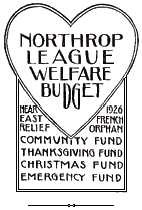
NEAR EAST RELIEF
1926 FRENCH ORPHAN
COMMUNITY FUND
THANKSGIVING FUND
CHRISTMAS FUND
EMERGENCY FUND
THIS year, when Community Fund interests brought to our attention the need of school collections, of which the Community Fund is but one, we thought to have a single large drive instead of several small drives.
We called in the expert opinion of one who had long worked in social agencies, and worked out a scheme and a budget for one drive covering all our needs. This plan was presented to the League Council and met with approval.
Sheets containing lists of the various funds for which money was to be collected, were given to the pupils to take home for conference with their parents. If a girl wished to give to any one of the various funds, she was to mark down that amount, also putting down the date of payment (any time until February 1); or else the money might be sent right back with the pledges. In this way we tried to make the idea of voluntary subscription the whole basis of our plan.
The total amount of the entire drive, both pledged and paid, is $902.13, out of which $359.58 was paid in full to the Community Fund. The total of the Thanksgiving Fund was $166.10, out of which $106.23 was paid for Thanksgiving baskets which were filled with good, substantial food, and were delivered by a number of the girls, each group accompanied by an older person, to eighteen needy families. The Christmas fund total reached the sum of $180.70. From this, we gave $75.00 as gifts to the house-staff. The Emergency Fund amounted to $151.25. From this, we gave $36.00 to help support a French orphan for whose care we are responsible.
There is also an unapportioned fund. A number of pledges were returned with only the total amount marked down, none of which was divided among the funds. These amounts were put down under the unapportioned fund. From this sum, we drew $30.00 for the Near East Relief. In addition to all this, we are having a continuous drive for old clothes which we place where most needed.
After the various distributions were made, we found that our book balanced with that of the League treasurer.
Handling a situation of this sort has been an interesting task, and I think that we all have greatly profited by the experience, and believe that it has been a preparation for future service to the Community.
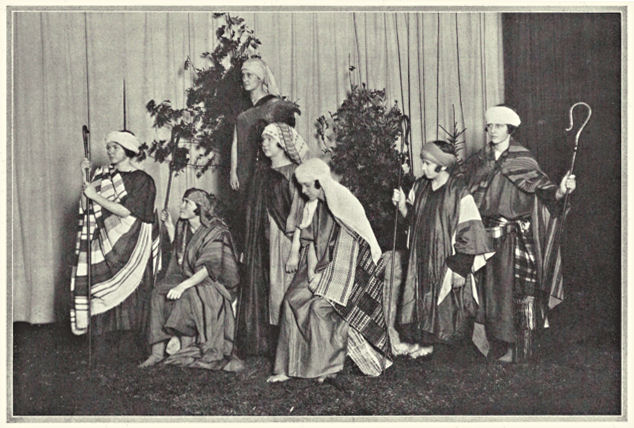
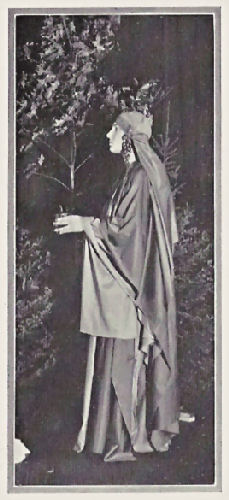
OCTOBER
2—Old Girls’ Party for the New.
16—Riding Contest.
NOVEMBER
10—Book Exhibit.
13—Junior Carnival.
DECEMBER
18—Christmas Luncheon.
19—Christmas Play.
FEBRUARY
5—Parents’ and Teachers’ Dinner.
12—Valentine Party for Grades VII and VIII. Reading by the Princess Rahme Haider.
MARCH
8—Lecture by the Duc de Trevise.
19—Northrop Entertains Summit.
25—Athletic Banquet.
26—Lecture by Dr. Cora Best.
MAY
20 and 21—Junior Field Day.
27 and 28—Senior Field Day.
JUNE
4—The Junior-Senior Dance.
7—Senior Chapel. Alumnae Luncheon. Class Day.
8—Commencement.
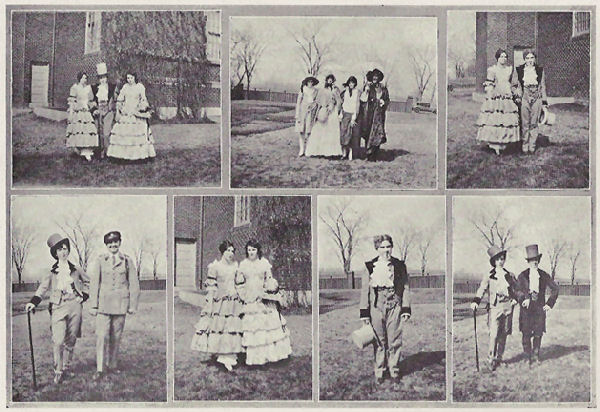
ON Friday morning, May 29, 1925, each Junior awoke with the entire responsibility of the Junior-Senior dance on her shoulders. Ten o’clock found some of the class in an effort to carry out the green and white color scheme, robbing the neighbors’ bridal wreath hedges of all their glory. Returning to school they wound the blossoming sprays in and out of a white lattice work, which a few of their industrious class mates had made to cover the radiators in the dining room. They then hung green and white balloons in clusters from the side lights. While this was being done, others were converting nice-looking automobiles into furniture vans. The furniture was arranged on the roof garden, over which Japanese lanterns were hung.
Having finished these tasks, we had by no means completed our work. The supper tables next occupied our attention. These we arranged in the side hall. Centering each was a miniature white May pole wound with green and white streamers. The appearance was festive indeed.
After the lapse of a few hours the weary Juniors returned to welcome their guests, the Seniors.... As the clock struck twelve, the music ceased, the building resumed its former tranquility, and the happy guests filed home.
EVERY year Northrop and Summit schools come together at one place or the other for an informal party. This year, it being our pleasure to entertain the Summit girls, we looked forward to the occasion as one of our most enjoyable events.
We departed from the usual form of entertainment in presenting the French play “Le Voyage de Monsieur Perrichon.” Although probably not every one in the audience understood all the speeches, the play went off well, for the plot is such that it is easily comprehended through the acting; also to aid the audience a short synopsis was read in English before the curtain rose, by Shirley Woodward, who looked the part of a dashing French soldier.
The roles of that amusing pair, Monsieur and Madam Perrichon, were taken by Betty Long and Barbara Bailey. Henriette, their daughter, was portrayed by Anne Healy, and the two charming lovers, Daniel and Armand, by Dorothy Sweet and Janet Morrison.
An additional feature of the program was provided by the faculty sextet, in the form of several pleasing songs. After the play, the faculties of both schools had refreshments upstairs, and dancing followed in the gymnasium.
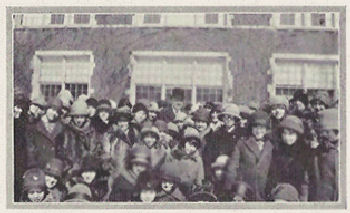
LE huit mars nous fûmes très heureuses d’avoir avec nous le Duc de Trévise. Comme Mlle. Carse était dans l’est, Mlle. Bagier le présenta. Il fit une conférence des plus intéressantes sur la reconstruction de l’ancienne architecture de la France, accompagnée de projections charmantes de son sujet. Il expliqua de son ravissant accent français, les dégâts qu’on fait aux beaux édifices du moyen âge. Il nous soumit le projet de son organisation pour conserver divers anciens châteaux, aux villages différents de la France pour chaque ville américaine qui aura approprié de l’argent pour cette cause, donnant ainsi le moyen aux citoyens de chaque ville d’avoir un logis quand ils visiteront le village ou la ville dans lesquels leur château particulier se trouve. L’argent qu’on a déjà donné a fait beaucoup pour avancer le travail de la reconstruction. Nous fûmes charmées de découvrir que, quand il retombait dans sa langue natale, nous pûmes avec peu de difficulté le comprendre. Après que la dernière projection eut été montrée, le Duc voulut beaucoup une photographie des élèves de Northrop School. En conséquence nous nous assemblâmes au côté sud de l’école où Mlle. Bagier fit deux photographies des jeunes filles avec leur ami nouveau-trouvé. Comme cela fut une grande occasion pour les plus jeunes filles, elles démandèrent à grands cris des autographes que le Duc leur donna avec bonté. Ensuite on nous rappela à nos leçons qui nous semblèrent plus tristes que d’ordinaire par contraste avec l’heure très interessante que nous venions de passer avec le Duc.
IT would seem that the good angels were plotting in favor of Northrop School, for this year we have had one delightful entertainment after another. Foremost among these events was a visit from the Syrian princess Rahme Haider and her charming companion Miss Burgess, who gave us a fascinating dramatic reading from the Bible. The entire school was held spellbound by the art of the princess, who made a very artistic appearance in her Oriental garb and had a charming personality. Princess Rahme Haider most assuredly gave us one of the most interesting and profitable programs of the year.

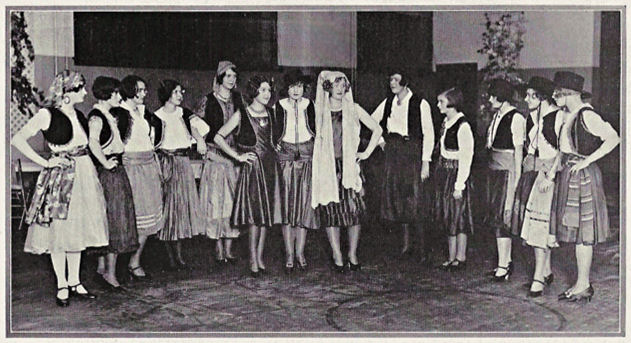

October 2—The Riding Contest.
BASEBALL
November 2—VII, 2; VIII, 22.
November 19—VII, 3; VIII, 25.
November 24—VII, 5; VIII, 26.
HOCKEY
November 9—Senior, 1; Sophomore, 1.
November 10—Junior, 5; Freshman, 0.
November 12—Senior, 0; Freshman, 0.
November 16—Senior, 0; Junior, 6.
November 18—Sophomore, 8; Freshman, 0.
November 19—Sophomore, 3; Junior, 0.
CAPTAIN BALL
March 3—VII, 2; VIII, 10.
March 9—VII, 2; VIII, 3.
March 11—Gold, 3; White, 10.
March 16—Gold, 7; White, 8.
BASKETBALL—INTERCLASS
February 23—Junior, 13; Sophomore, 6.
February 25—Freshman, 9; Sophomore, 20.
March 1—Senior, 8; Sophomore, 10.
March 2—Junior, 24; Freshman, 11.
March 4—Freshman 5; Senior 5.
March 8—Junior, 12; Senior, 19.
March 11—Tournament—Junior, 11; Sophomore, 8.
BASKETBALL—GOLD AND WHITE
March 10—Gold I, 7; White I, 8.
March 15—Gold II, 7; White II, 7.
March 22—Gold III, 22; White III, 6.
March 23—Gold IV, 11; White IV, 7.
March 24—Gold A, 12; White A, 7.
FIELD DAY
May 21 and 22—Junior Field Day.
May 27 and 28—Senior Field Day.
THIS year a new regulation in regard to hockey practise was introduced. The girls were required to report twice a week instead of once, one of these days being given to stick practise.
The first game of the season was played on November ninth between the Seniors and the Sophomores. It was a very close one resulting in a one to one tie. On the next day, November tenth, the Juniors beat the Freshmen by a score of five to nothing. The game on November second resulted in another tie; this time a scoreless one between the Seniors and the Freshmen, which was most unsatisfactory to both teams. On November sixteenth the Senior-Junior game was played which the Juniors won six to nothing. On the eighteenth the Sophomores won from the Freshmen eight to nothing, and on the next day the game between the Juniors and the Sophomores was played. As no one had crossed the Juniors’ goal since the beginning of the ’24 season there was a great deal of interest in the game. It was an exceedingly hard contest, two girls being more or less knocked out during the game, but the Sophomores won by a score of three to nothing.
We were fortunate this season in having the weather remain so that we were able to play all the games on the schedule.
THE annual riding contest was held on the Parade Grounds, Friday, October 16, Mlle. Bagier and Betty Fowler acting as managers. Although it was a cold and wintry day, a large crowd turned out. Dr. E. W. Berg, Mr. L. McFall, and Mr. William Hindle were the judges, and the Misses Anderson acted as ring mistresses. Everything went off very smoothly, beginning with the Junior Cup Class, followed by the Senior Cup Class, the Pony Class, and ending with Five Gaited Class. After the contest, tea was served in the gymnasium, where the awards were given out. The Junior Cup went to Ruth Clark; the Pony Cup, to Virginia Leffingwell; the Five Gaited Cup to Betty Fowler; and the much desired Senior Cup to Mary Louise Sudduth.
ON the fall the Sevenths and Eighths had several baseball games. They were very exciting in spite of the fact that the Eighths always won by a generous margin. However the Sevenths took the defeats so well that no one could call them “poor losers.” After the snow came, captain ball began. The two match games were very interesting. The score of the first was 10-2 in the Eighths’ favor, and of the second was 8-7, the same side being victorious. Then came the Gold and White games, both of which the Whites won. It was hard, but it was fun, to play against a girl that one had previously played with as a partner. These games brought out such good sportsmanship that we all enjoyed them.
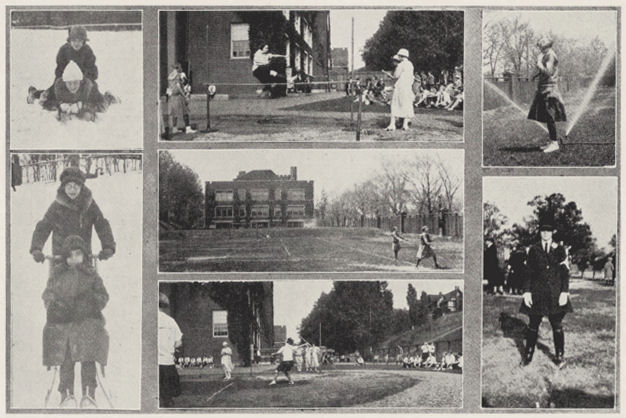

THE basketball season opened with much enthusiasm as soon as school began after the Christmas vacation. The attendance at practices was especially good this year, and the members of every class reported regularly. In order to arouse some spirit, each class distributed its colors among its rooters, and there was much competition between the classes in finding original yells. As a result of these efforts the crowds at the games were exceptionally good, much larger than in previous years. The Sophomore-Junior game, the first of the season, was won by the Juniors after a hard fight. The next two games were the Sophomore-Freshman and the Senior-Sophomore, which were both won by the Sophomores. The Juniors then played the Freshmen and were victorious. The Senior-Freshman game, one of the most exciting of the season, ended in a tie, much to the disappointment of both sides. The Seniors in their last game at Northrop played the Juniors and won. As a result of these games, the Juniors and Sophomores were competitors in the tournament.
The girls worked hard to make the gymnasium look suitable for the occasion and were rewarded for their efforts, for cheering and enthusiastic crowds filled the gym. The best yelling of the evening, however, was done by the Sophomores, who nearly raised the roof with their snappy and well-led cheers. Their serious and well performed stunt of forming and singing, contrasted with the ridiculous showing of the Juniors made on tricycles. After the stunts, the game began and certainly proved to be a close one. Although the Juniors were behind during a good part of the game, they finally won by a score of 11-8. The tournament closed the inter-class games and those of the Gold and White teams began.
In order that more girls might take part in the games, the upper school had been divided into two large teams called the Gold and White. These teams were in turn subdivided into basketball teams, and many games were played between these teams. Although the audiences were not all that might be desired the plan can be called a success since it interested more girls in the game. The White team won the first two games and the Gold the next two; therefore the final game between the two “A” teams would decide whether the Gold or the White team would win the basketball series. The game was won by the Gold team, 11-8. This game ended the basketball season, which has been an unusually good one.
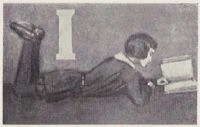
BOOKS are the means by which one may travel without moving. It is through the medium of a book that I was able to visit a garden in Italy. It happened to be a garden that was typically Italian and a very charming one. The entrance was through a vine-covered Tuscan arch at the side of a villa, and down several steps to a wide terrace. The sun was beating down outside, but inside this walled garden all was cool and refreshing. At one’s feet were clumps of darkest green ferns, like miniature forests. At the bottom of the terrace there was a terracotta pool, where water flowers were drifting on their flat green pads. Around the edge of this pool and through an aisle of tiny fragrant pink rose bushes was a space enclosed on three sides by feathery greens. Here a laughing satyr was perched on the top of a fountain, spouting water in a silvery arc. Through a shaded avenue could be seen other secluded spots with marble benches in front of other fountains. In another direction was a grotto where water trickled down gray, moss-covered stones. Far in the distance were cypress trees waving their spear-like tops and standing guard over the coolness and beauty of the garden.
Very different from this is the sunny English garden that next I visited. It, too, was terraced and had fountains, but the water in these fountains sparkled in the sun, and the cool dampness of the Italian garden was lacking. On the terrace were occasional closely-trimmed yew trees, or box trees clipped in odd shapes. A curving walk, edged with laurel, led to the ivy-walled inner garden. Here, in the full sun and warmth, grew, not the delicate rose bush of my Italian garden, but sturdy, bold rose trees, and apple trees, above snowdrops, daffodils, and crocuses in round, oblong, and square beds. These had trimmed herbaceous borders, and gray flag walks lay between them. Beyond towered great elms, but even these did not shut out any of the sun, which reached the foxgloves and violets, transplanted from the moor to the corner of the wall.
Here in America, though I have never been East, I know I should feel at home in a New England garden. My entire knowledge of them has been gained from books, but I am sure, from what I have read that these gardens are quite as charming as the more formal ones of other lands. Separated from the street by either a white picket fence or a row of lilac bushes, grow in their seasons nasturtiums, pinks, larkspur, mignonette, sweet peas, and forget-me-nots, in neat rows. All these are in such profusion that one sees only the glorious general effect and fails to notice that the garden has been planted with total disregard to the blending of colors. At the back, against the fence, tall sun flowers flaunt themselves, while in front are clumps of gorgeous peonies, and at the side beds of fragrant mint.
All these gardens I think of when spring comes, and my yearly gardening fever seizes me. But at the end of two months, when my radishes go to seed before attaining edible size, and those of my flowers that are not choked by weeds have been dug up by other members of the family, I go back to the dream gardens in my books.
AN old man, ragged, but with an air of dignity, quickly glanced at his stop watch as a small figure, crouched over a shining black neck, shot by. With a thunder of hoofs the black horse whirled past and fought for her head down the stretch. She would win the following Saturday—she must! If she didn’t then she too would have to go and leave the ruined old gentleman, who looked so feeble leaning over the white rail which enclosed the mile track. After much coaxing the black colt came mincing up to her old master.
The small colored boy, as black as his mount, was bubbling over with enthusiasm. “Dat dehby, Suh, is going to be won by ma Dixie,” patting the curved neck of the horse.
The old gentleman looked up. “Mah boy, you must remembah that Dixie will have otheah good hawses to beat. Vixen is the favohite and very fast, although Ah know mah little black friend heah will do heh best to honah the purple and white,” glancing proudly at the headband of the black marvel. “Next Satahday will decide it all.”
A shadow fell across the colt. Looking up, the gentleman, known as Colonel Fairfax, saw a man dressed in a checkered suit and orange socks. On a tie to match was a monstrous, well polished diamond, which sparkled wickedly in the sun. The man stood staring at the stop-watch. “Ah beg yoh pahdon, Suh, but theh anything Ah could do foah you?”
The man, hearing the question, looked up, flushing. “Youh horse is a Derby entry?”
Colonel Fairfax eyed the horse reflectively and answered, “It all depends on her condition, and only time can answeh that.” The man hurried away, leaving the old gentleman looking after him, a deep frown on his face.
“Washington, Ah am a bit doubtful about this new-uh-acquaintance,” he addressed the exercise boy.
Each day, no matter how early Dixie was given her exercise, the stranger was to be seen loitering in the distance or walking briskly beside the track—seemingly deep in thought. His presence seemed to trouble the Colonel, who watched his colt anxiously.
At last, the final workout. Colonel Fairfax and the unwelcome stranger leaned over the rail, intently watching the black horse, which appeared to have wings. The stranger, who had been seen talking to the owner of Vixen, the favorite, annoyed the old gentleman; he was suspicious of this flashily dressed man and did not conceal his feelings.
Sundown, Friday, found the stable at Churchill Downs buzzing with excitement. The favorite’s stall was surrounded by interested old racing men, who loved the thoroughbred and his sport, while a few individuals in gaily checkered suits crowded about, listening to the many “hunches” for business reasons only. An old man sat before Stall No. 7. Glancing up, he noticed two men peering in at Dixie. One was the man who had seemed so much interested in the mare’s trial gallops. Through the half-open door of the box stall could be seen a horse in faded purple and white blankets. After a hurried conversation the two men passed on to the favorite’s stall, where they smiled at the jockey, looked in, and walked on.
Long after the one-thirty special night train had whistled at the Downs crossing, a dark figure could be seen sliding along the stall doors—“Ten—Nine—; Eight—” Then it came to halt before Stall No. 7, and slipped through the door. It felt in the dark for the blanketed horse’s neck. The horse jumped as a dagger-like needle was thrust into its neck. The colored boy, in a drugged sleep at the door of the stall, stirred in his dreams, but was still again. The door opened quietly, and the figure slipped out, leaving the horse in No. 7 leaning drunkenly against the side wall. A shaft of moonlight fell across the intruder’s face, revealing the same man who had attended all of Dixie’s trial gallops. Little did this unscrupulous person realize that the black mare was spending the night in an old deserted barn near the race track, guarded by an old gentleman whose mouth was twisted into a whimsical smile, while a “guaranteed-to-be-gentle” livery horse was leading a life of luxury that evening in Stall No. 7, Churchill Downs.
Derby day at Churchill Downs! Kentucky was doing homage to the thoroughbred. As the band played “Dixie,” the Derby entries filed through the paddock onto the field. Proudly leading the string of the country’s best two year olds, was the song’s namesake, a true daughter of the South. With arching neck and prancing feet, Dixie, the pride of an old man’s heart, took her place at the barrier. Her jockey looked up as he passed an aristocratic old gentleman, dressed in a faded coat which reminded one of “befoah de Wah” days and whose hat remained off while the horses passed.
The barrier was up, and the roar shook the grandstand. “They’re off!!” The favorite, Vixen, shot ahead and seemed to be making a runaway race. Cheer after cheer rent the air. An old man clasped his program a little tighter and breathed a prayer. Around the turn came Vixen, but not alone. Crouched to the ground, a small black horse crept up to the flying tail of the favorite. Down the stretch the two thundered, fighting for supremacy. “Foah Kentucky, Dixie, and the honah of the purple and white!” As if she heard this plea from her master, Dixie bent lower. Then, her black nose thrust ahead, more than a length in advance of Vixen, she flashed under the wire, bringing “honah” to the purple and white.

MY bureau drawers,—I wonder what their contents could tell! Whenever I go through them with the firm resolve to clear out everything that I do not actually use, I always end by saving some things just for the sake of the memories connected with them.
Take that pink satin hair ribbon, for instance. I wore it for the first time with a new pink dress at a party in California. It brings back all the thought of California as I first saw it in nineteen twenty, memories of stately and haughty poinsettias, of date palms from which one could pick and eat fresh dates, of a dancing ocean with its myriads of lovely sea creatures, and its gaily-colored beach equipment, of an amusement park with the roller coaster on which I nearly had heart failure.
Then, in another corner, lies a string of green beads. What could better recall to my mind the night of my graduation from the grade school? The recollection makes me want to be in grade school once more. I well remember how one of my classmates forgot to bring the music to the class song which was to have been one of the attractions of the program. Disaster marked that evening farther when a tall Danish boy, looking the picture of selfconsciousness and misery, arose to give the farewell address. As nearly as I can remember, it ran thus:
“Ladies and gentlemen, on the evening of our graduation ve vish to tank de teachers and also de principal for de vork”—a long awkward pause—“ve vish to tank de teachers and also de principal for de vork”—a still longer pause, interspersed with rising giggles from the graduating class—“Ladies and gentlemen, ve vish to tank de teachers and also de principal for de vork vich they have done in getting us trough.”
Then, there at the back of the drawer, is a black satin sash. It brings to my mind an entirely different kind of memory. It is one thing that I have left from the dress I wore at my grandfather’s funeral. I remember all the tragedy of the occasion, lightened by one spot of comedy, my grandmother’s losing her petticoat.
I dare say that some day I shall throw away these things that others consider rubbish, but I shall never part with the memories for which they stand.
IT was early in the morning when Nancy Nelson awoke. She got up and put on her wrapper and one slipper, as she couldn’t get the other one on, though she tried hard. “Ah,” she said, “there must be something in my slipper.” So Nancy felt in her slipper and then pulled out her hand. Why, there was a little package! “Who put it in there, I wonder,” she said, quite surprised. Nancy asked everybody in the house. Then her mother said, “Nancy, did you forget that it is your birthday?” Then she opened the little package and found a small silver thimble, with the name “Nancy Nelson” on it.

IT was a clear, warm day in late spring and a ship was leaving the harbor, its departure accompanied by a merry clanking of chains as the anchor was drawn up. The lusty cheers of the sailors floated back in echoes. The shore was crowded with the wives and sweethearts of these two hundred sailors, their brightly colored gowns and fluttering handkerchiefs making a lovely picture against the background of the green cliffs. On board the men were singing lustily as they performed their tasks and the last echo of their happiness floated back clearly to the little group on the shore as the ship dropped below the hill and out of sight. The women had already settled down to their period of watchful waiting and were trusting the safety of their loved ones to God, who had always protected them and brought them home safely before.
It was a clear, crisp night in late October and the moon was sending its silvery beams out over the quiet waters. Everything was pervaded by an air of mystery. Slowly, from far out at sea, a great ship came slinking into the harbor. As it drew nearer, it glowed with crimson lights. Then, suddenly every light went out and again the great mysterious hulk was swallowed up in the darkness. Not a sound was heard. Could this be the same ship that had sailed away so gayly three years ago? No one awaited its coming, for it had been long given up for lost. It came nearer and nearer, and a breeze, which had suddenly come up, whistled through its thin sails and moved the spars, making a sound like the rattling of dry bones. Then, as if in response to the command of a ghostly captain, the great, black hulk sank into the darkness under the water, leaving only a whirlpool to mark its existence. It sank as it had sailed in; slowly and mysteriously.

MARY had been assured that “Dolly” was absolutely dependable, would not shy, had a kind and gentle disposition, and was easy to manage; but now she was actually gazing upon this amiable annihilator, the courage oozed out of her suddenly pounding heart and her eyes widened with fright and suspicion. She wished now she hadn’t been so desirous of tempting fate on such a seemingly ferocious and unnatural brute.
“Dolly,” on the other hand, happily unaware of his savageness and unnatural spirit, drooped his homely, ungainly head in a dejected manner. To him, Mary was only one more burden, one more wriggling, gasping infliction, to be jogged slowly about for her first ride. He snorted in disdain. Mary jumped. Why didn’t she use her own feet? “Dolly” didn’t want to be bothered. Finally he rolled an eye back to survey his passenger.
The groom was gradually coaxing Mary on—onto something terrible. She just knew it! “Dolly” seemed to assume supernatural proportions as Mary reached out a hand to grasp the reins which were handed to her. Someone boosted her on. Goodness! She was going right over on the other side! But no! She found herself sitting up on the broad back of “Dolly”; it was a very precarious position. How did one keep one’s balance? She just knew she couldn’t stay on. There was nothing to hang onto, and her....
“Help!” she shrieked, as her steed casually stamped a clumsy foot, in the endeavor to rid himself of a persistent fly.
The groom, now mounted, led her horse out into the ring. Mary hoped he’d hang onto the reins. If he didn’t.... Mary pictured herself a mangled, shapeless mass. She shuddered. She’d seen those movie actors dart gaily about and had thought it would be lovely to learn to dart. But now—she wondered if they had been tied on!
Oh! they were jogging. Mary didn’t seem to understand the nature of the jog. She was out of breath. Grasping the pommel, she looked miserably at the long neck swaying in front of her. Two long ears fascinated her. Up and down, up and down. Ah! why didn’t he stop? She attempted to shriek, but only succeeded in emitting faint gasps as “Dolly” swerved to avoid a small hole. Inside she seemed to be jolted to pieces. Her heart shook her chest, and a giddy feeling overpowered her. Her vision blurred, and her breath came in short gasps.
“Dolly” had now slowed down to a walk, but to Mary this was the wildest of gaits. Every minute she fully expected to die on the spot. She couldn’t stand it another second. She couldn’t—she couldn’t!
“Time is up, Miss,” announced a cheery voice. “Do you wish to dismount?”
Mary came up from the depths of agony, and hope lit her face.
“Oh-h-h!” she moaned. “Yes, I—Yes! Yes!”
She was lifted, or rather dragged, off, she didn’t know which, didn’t care as long as she was off. The ground seemed to come up to meet her. Why didn’t things stand still? Even the unsuspicious “Dolly” appeared to be performing grotesque antics. Mary took a step, just one. It was not necessary for her to take more to realize that she was very stiff. “Heavens!” She slowly gathered up her coat and hat, and limped painfully out of the Academy. Now she could realize that an amateur, in riding anyway, had her troubles in walking!
IT is last period on a long, sleepy, particularly humdrum day at school. Shirley sits trying to concentrate on a history text-book, but her mind will wander, despite her really noble efforts to distinguish the Valerian Laws from the Licinian Laws.
“What an idiotic law to have to make!” she mutters resentfully. “But I’m sure I shouldn’t be so dumb in History if I had an interesting text-book. It seems as though someone could write it, even if we aren’t all Van Loons and H. G. Wellses. I bet I could myself—at least I’d make it a fascinating book if not a strictly exact one (‘Yes you would,’ says her Subconscious, but she pays no attention)! When I think of the generations of defenseless students to be subjected to these text-books, my heart aches for them!... The Valerian Law was....”
The scene changes from this lethargic one to a fireside on a winter evening. She drops the book in her lap, the yells of the savages are fainter. She shakes the salt spray from her chair and tries to adjust herself once more to the prosaic of a land-lubber.
“To write a book like that is my only desire on earth,” she murmurs, as she reaches for a volume of Jane Austen.
Now, completely involved in the career of Emma, she says, “Oh, for that gift of the gods Jane Austen had! Her speech—a rippling stream of perfect and delicious English, the King’s English indeed! Each phrase is as delicately constructed as a watch, and all her watches tick together as one.”
Thus the incorrigible child goes on, unaware how many fascinating books she has longed to have written. From Nicholas Nickleby to Thunder on the Left, from Walter H. Page to the Constant Nymph, and from Chaucer to Edna St. Vincent Millay! A veritable gourmande, she is.
But forgive her. Who has not felt that he might improve a text-book? Who has not longed, in reading a glorious book, for similar brilliance? What lover of books is unmoved to an occasional effort at emulation, even if he afterwards destroy it? You who do these things, sympathize with Shirley, who, by her own hand we do confess, is bitterly disillusioned every time she tries to write a theme.
THREE Indians padded softly along through the tall dark pines. Their errand seemed peaceful, since their number was so small and they came so openly. Soon the path widened out, and finally led to a small glade in which stood a rough cabin. The Indians stopped to observe cautiously before making themselves known. What they saw filled them with curiosity and awe, for standing before the cabin was a white man praying, his deep voice echoing through the wild stillness of the forest. Beside him stood a younger man, whose attention, while respectful, was not undivided, for he had spied the Indians and waited restlessly for the “father” to finish his devotions. These done, he called his superior’s attention to the savages lurking on the outskirts of the glade and beckoned to them to come forward. Both white men were eager to learn what the Indians might tell them, and the elder, who spoke the Indian tongue, talked glibly with the redskins. They, in turn, were curious about several things. First, the strange contrivance that hung from Father Hennepin’s belt. He explained that it was to help him find his way through the uncharted country. Save for the compass he would quickly be lost.
“Hugh,” grunted one of the braves, “that no good. I lead you,” surprising the Jesuit by his use of English.
“Good,” answered the priest. The two white men went into the cabin, gathered their scanty baggage, and reappeared at the door. By this time the other Indians had disappeared down the path by which they had come. In the opposite direction, without a backward glance, the party of three men, the Jesuit, his companion, and the Indian guide, set out to find new thoroughfares.
Now from morning to night traffic rolls along the same trail. The narrow path that once found its way through the forest with many turnings and twistings is now a wide, paved avenue. Over it go street cars carrying busy people, trucks laden with gravel or coal, the ever-present automobiles of people bent on pleasure. The street is lined on either side with tall buildings: stores, offices, houses, churches, museums. As we go down the avenue, we come to what was once a clearing in the forest. Instead of the simple cabin, there are now a variety of buildings: a small store whose owner, a French Canadian, carries on a thriving business; opposite, a restaurant owned by two yellow Chinese, who specialize in chow-mein; next door, the establishment of a husky Yankee, who plies his trade by greasing automobiles and supplying gasoline to motorists demanding that necessity.
A thriving community now, what will this one time forest clearing be two hundred years hence?
At dinner Daddy told us he had seen a prince. I asked him what prince it was.
Then Mother said, “Didn’t you read the paper, Ella Sturgis?”
“No,” I replied.
“It was the Prince of Greece,” said Daddy, “and he wore a monocle.”
Chucky said, “What is a monocle?”
“It is a glass people wear in one eye and squint a little to keep it in,” said Mother.
Then she asked Daddy where he had seen the prince.
“At the club,” he replied. “I was invited to have lunch with him, but I could not accept the invitation because I had promised Ella Sturgis to do something for her dog, and Ashes is more important than the Prince.”

IN about 1855 Mr. W. H. Grimshaw came to live in Minneapolis where the Plaza Hotel now stands. Then Loring Park and the vicinity was farm land, and an Indian named Keg-o-ma-go-shieg had his wigwam at the corner of Oak Grove and Fifteenth streets. Mr. Grimshaw learned from him that Indians had lived on this spot for generations, but that since the land had come under government control, most of the Indians had gone. Keg-o-ma-go-shieg, because he loved so much the spot where he was born, returned every summer to fish in the lakes and hunt in the woods of his beloved birthplace. There is no tablet or monument to this last Indian in Loring Park, but there is one to Ole Bull facing Harmon Place. Would it not be more fitting to have a statue of Sitting Bull?
Also there used to be an old, well-traveled Indian trail through the Park, of which there is no trace now, although some people have searched carefully for it. According to Mr. Grimshaw there used to be countless passenger pigeons, which in the migratory season roosted in the trees of Loring Park. At noon the sky would be darkened by a cloud of these birds, the air would be filled with the sound of their wings, and they would alight on the branches of the trees, nearly breaking them down by their great weight.
Then there was the old brook that flowed out of Loring Park lake, across Harmon Place, under the present automobile buildings, and emptied into Basset’s Creek. The old military road from Minnehaha Falls to Fort Ridgley ran through this section, roughly along Hennepin Avenue.
West of Hennepin Avenue was Ruber’s pasture, where cows and horses used to graze, and where the Parade Grounds, the Armory, the Cathedral, and Northrop School now are. Mr. J. S. Johnson was the first white settler in this part of Minneapolis. In 1856 he bought one hundred and sixty acres, of which a part is now Loring Park, for one dollar and twenty-five cents per acre.
“Now if you will be quiet I will tell you a story,” said Miss Smith.
“All right,” said Tom, “but you must tell us a story about a pirate.”
“No!” cried Betty, “tell us a story about a fairy.”
“Be quiet or I will not tell you any story,” exclaimed Miss Smith.
“Please tell us a ’tory bout ’ittle baby,” pleaded baby Ruth.
“All right, the story will be about a little baby. You two older children ought to know better than to shout,” sighed Miss Smith.
“Oh dear, we never get anything now that Ruthie is old enough to let you know what she wants,” groaned Tom.
“Once upon a time,” began Miss Smith, “there was a ...”
“Pirate,” interrupted Tom.
“No, no,” said Miss Smith as she went on with the story. “Once upon a time there was a ...”
“Fairy,” interrupted Betty.
“No, a little baby,” cried Ruth.
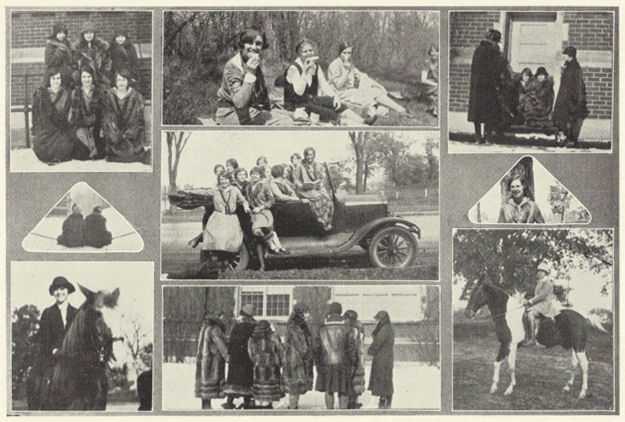

IF you would enjoy a glance at the home of one of the winds, read At the Back of the North Wind, by George MacDonald. Young Diamond, a little boy, the North Wind, Diamond’s father and mother, and Old Diamond, which is a great and good horse,—these are the characters you will hear the most about in this story. The story narrates a series of adventures, in dream form, of Young Diamond and an uncanny creature who calls herself the North Wind. An unusual part of the story is the trip to the sea where the North Wind will destroy a ship. Diamond does not want to perceive this, so North Wind drops him in a great cathedral, where he wakes to see the moon-lit windows showing the saints in beautiful garments. If you like fairy tales, I would suggest that you read this incredible book.
My dear friend:
I do so hope you will like the book Dandelion Cottage. It is an interesting story of four little girls named Betty Tucker, Jeanie Mapes, Mabel Bennett, and Marjorie Vale, who pay rent for a cottage by pulling dandelions. They have such interesting adventures and act so business-like that you ought to love it. I did when I read it. Carroll Watson Rankin certainly knows what girls like, for she has innumerable objects in that cottage that I know you would love to have in your room. It is very clean in the cottage, with not an atom of dirt anywhere. The part I like best in the story is where Laura Milligan, a disdainful little girl, moves into the neighborhood. She makes life miserable for the cottagers. When you read the story, be sure you look very carefully for the things Laura does, for they are very interesting. I know you prefer to read the book yourselves, so I will close now.
Sincerely yours,
Barbara Anson, Form V.

YOU would be very much interested in the story of Krag and Johnny Bear, by Ernest Thomson Seton. The names are very cute. There are Nubbins, his mother, White Nose, and his mother. This part of the story tells about Krag, an extraordinary little sheep, who has many fascinating adventures. Little White Nose is very lazy, obstinate, and wary. Every morning Nubbins gets up and tries to wake up White Nose. When Krag grows up, he has beautiful big horns, and the hunters try to catch him so they can mount them. At the end of the story he is caught and his horns are mounted and kept in the king’s palace. I know you would like to read this book if you are fond of animal stories. Another interesting story is about Randy, an extraordinary sparrow who is brought up with some canaries and learns to sing. One day the cage Randy was in fell over with an astounding crash and he escaped. He built a nest of sticks, which was the only kind he knew, and was very disconsolate when his mate, who was an ordinary sparrow, threw them away and brought hay and straw instead. Randy’s mate is finally killed and Randy is caught and put back in his cage. I think you will like this book if you like animal stories.
IT was a cold and frosty morning at Mr. Brown’s farm. The pumpkins were huddled together, and their frosty coats glistened in the morning sunshine.
“I heard Mr. Brown talking about Thanksgiving,” said a little pumpkin. “I wonder what Thanksgiving is?”
“Long ago,” began a big pumpkin, “when the first white people came to this country, it was in early winter, and these settlers could raise no food. Many of them died of hunger and cold. But the next year the settlers planted many crops, and they grew wonderfully. So they had a day to thank God for the crops they had. The day they celebrated is called Thanksgiving.”
“Oh, I see,” said the little pumpkin. “I am sure Teddy was thankful he had such a nice big pumpkin to make his Jack o’ lantern out of on Hallowe’en.”
“I think the cattle are thankful that they have us to eat in winter,” said a middle-sized pumpkin, trying very hard to look wise, but the November air was so delightfully chilly and crisp he had to laugh.
“I’m sure Farmer Brown and his family are thankful to have such a nice pumpkin pie every Thanksgiving,” said a big pumpkin.
“I never knew pumpkins were so useful,” sighed the little pumpkin sleepily. Then he turned over and went to sleep.
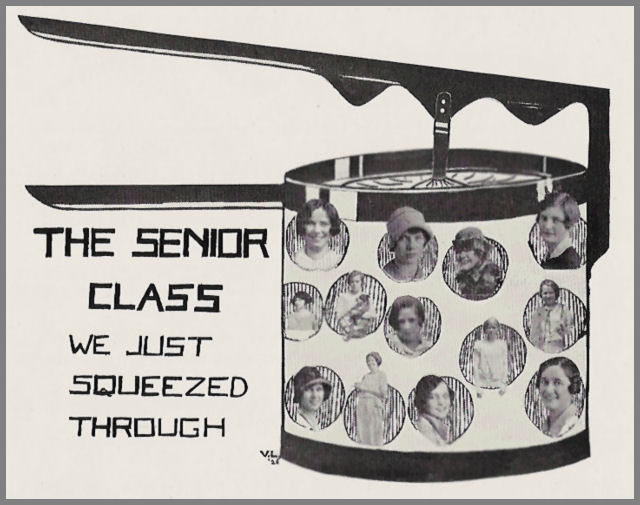
CADILLAC
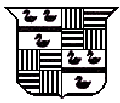
Millions of boys and girls of today are eager partisans of the Cadillac—anxious to grow up and have a Cadillac of their own, like Father and Mother.
With thousands, the ownership of a Cadillac is a family tradition dating back to the days when Grandfather bought his first Cadillac, a quarter of a century ago.
All through these 25 years Cadillac has consistently stood in the forefront of all the world’s motor cars.
Eleven years ago Cadillac produced the first eight-cylinder engine—the basic foundation of Cadillac success in marketing more than 200,000 eight-cylinder Cadillac cars.
Today the new 90-degree, eight-cylinder Cadillac is the ultra modern version of the motor car. Its luxury, comfort, performance and value reach heights of perfection beyond anything ever attained.
Thus once again Cadillac strikes out far in advance, renewing its traditional right to this title, The Standard of the World.
Northwestern Cadillac Company
LA SALLE TO HARMON ON TENTH MINNEAPOLIS
THE STORE of SPECIALIZATIONS
Prescribes for Youth and Summer Holidays
| The Girls’ Store | —suggests to the fortunate years between 6 and 14, that Wash Frocks have all the style charm, this season, of silks or crepes; that handmade Voiles are cool and always dainty; that white Middy Blouses are jauntier with matching Skirt; that Cricket Sweaters are “Sportsiest.” |
| The Sub-Deb Shop | —understudies the “Deb” in outfitting the “Sub!” Are your years between 13 and 16—here are Sports Frocks; decorative Georgettes; bright cool Prints for a summer morning; pastel Chiffons or buoyant Taffetas for the evening party. And in Coats—there’s the slim “wrappy”, the Cape-back. |
| When Youth Steps Out | —if it’s young youth, it chooses for smartness and comfort, a “Felice” Pump—in patent or tan calf, with matching buckles. If it’s more sophisticated youth—there’s the sophisticated Shoe; the Shoe of high, “Spiked” heel and daringly contrasted leathers—dainty, frivolous, charming! |
| The Hat Shop Says | —pretty much what you will this Summer! From small Hats of crocheted straw or silk, to pictorial Milans—for the Sub-Deb. From demure “Pokes” or off-the-face Beret-Tams to wide-brimmed, streamer-gay Straws—for the Junior. Here’s latitude for choice—and a Hat for every type! |

MINNEAPOLIS
Invest Direct
in Your Community’s Growth
Preferred Shares
Northern States Power Co.
50,000 Shareholders—15 Years of Steady Dividends
Make inquiry at any of our offices
MINNEAPOLIS FARIBAULT ST. PAUL MANKATO

POWDER PUFFS

Lovely women appreciate the daintiness and perfection of Gainsborough Powder Puffs.
Each puff with its soft, fine texture has the rare quality of retaining exactly the right amount of powder and distributes it evenly.
Gainsborough Powder Puffs retailing from 10c to 75c each, are available in various sizes and delicate colors to match your costume.
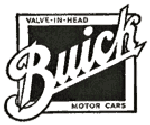
PENCE AUTOMOBILE CO.
MINNEAPOLIS
WHEN BETTER CARS ARE BUILT
BUICK WILL BUILD THEM
Compliments of
Miss Minneapolis
Flour
Minneapolis Milling Company
Compliments of
Winton Lumber
Company
Manufacturers
of
Idaho White Pine
Security Building Minneapolis, Minn.
JOHN DEERE
 Farm Machinery
Farm Machinery
TRACTORS
DEERE & WEBBER CO.
MINNEAPOLIS
JAMES C. HAZLETT WESLEY J. KELLEY
JAMES C. HAZLETT AGENCY
Any Kind of Insurance Anywhere
First National-So Line Building
FIDELITY AND SURETY BONDS MAIN 2603
ALLEN & KIDD
RIDING SCHOOL
Toledo Ave. and Lake St.
ST. LOUIS PARK
EDWARD J. O’BRIEN
REALTOR
Real Estate—Investments
232 McKnight Building Minneapolis, Minn.
Graham’s
ICES
ICE CREAMS
MERINGUES
Catering for All Occasions
2441 HENNEPIN
Ken. 0297
NOT ONLY NOW, BUT—
For centuries one of the best protections against poverty has been a bank account, and you have every assurance of protection when you make the
26th Street State Bank
Corner of Nicollet Avenue and 26th Street, your bank.
Sometimes the biggest is not the best, but we are the best because we are not the biggest.
Compliments of—
John F. McDonald
Lumber Company
One piece or a carload
MELONE-BOVEY
LUMBER CO.
4 Retail Yards
~
MAIN OFFICE AND YARDS
13th Avenue South and 4th Street
OCCIDENT FLOUR
Costs more—worth it
Barrington Hall Coffee
BAKER IMPORTING CO.
Minneapolis and New York
Thorpe Bros.
REALTORS SINCE 1885
Complete Real Estate Service
Owners and Developers of
The Country Club District
THORPE BROS.
Thorpe Bros. Building
519 Marquette Ave.
In the Heart of Financial Minneapolis
Compliments of
North Star Woolen
Mills Co.
Manufacturers of Fine Blankets
MINNEAPOLIS, MINN.

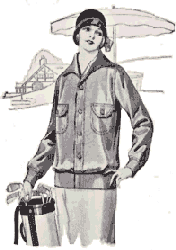 Of flannel and broadcloth in all the smart
plain shades, also novel checks and plaids.
Made with either roll sport or notched
collar and hip bands of either knit wool
or self material.
Of flannel and broadcloth in all the smart
plain shades, also novel checks and plaids.
Made with either roll sport or notched
collar and hip bands of either knit wool
or self material.
Nothing Like a
POLAR OVERJAC
playing around outdoors
There’s nothing like it for looks or for utility either. The jaunty lines, the natty materials, the exuberant colors—that will all appeal to you, and besides you’ll like the easy feel of it on you—the comfortable fit—the way it “gives” to your movements.
Whatever your plans for this summer vacation you’ll want a Polar Overjac. It’s the handiest thing imaginable to slip into—and just the right weight to give the little extra warmth needed cooler days and evenings. For driving, golf, for “roughing it” and all the rest. Well made, expertly tailored—that accounts for a lot of its good looks.
At Your Neighborhood Store
Made exclusively by

MINNEAPOLIS
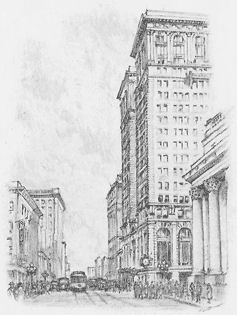
FIRST NATIONAL BANK
Minneapolis, Minnesota
Compliments of
DAVIS and MICHEL
ATTORNEYS-AT-LAW
419 METROPOLITAN BANK BUILDING
Since 1870
A SAFE PLACE FOR
SAVINGS ACCOUNTS
HENNEPIN COUNTY
SAVINGS BANK
511 MARQUETTE
The Oldest Savings Bank in Minnesota
The following names represent purchasers of advertising space in the Tatler, who have given the space back to us for our own purposes. We are especially grateful to them for this two-fold gift, and wish hereby to acknowledge their contribution.
| Mr. C. R. Williams | Mr. B. H. Woodworth |
| Mr. P. A. Brooks | Mr. V. H. Van Slyke |
| Mr. R. A. Gamble | Mr. W. A. Reinhart |
| Mr. C. M. Case | |
From the Press of the Augsburg Publishing House
Transcriber's Note
Obvious typographic errors (incorrect punctuation, omitted or transposed letters) have been repaired. Otherwise, however, variable spelling (including proper names, where there was no way to establish which spelling was correct) and hyphenation has been left as printed, due to the number of different contributors.
Page 19 includes the phrase "if the snow smelts." This is probably a typographic error, but as it was impossible to be certain, it has been left as printed.
End of the Project Gutenberg EBook of The 1926 Tatler, by Various
*** END OF THIS PROJECT GUTENBERG EBOOK THE 1926 TATLER ***
***** This file should be named 25926-h.htm or 25926-h.zip *****
This and all associated files of various formats will be found in:
https://www.gutenberg.org/2/5/9/2/25926/
Produced by Alicia Williams, Sam W. and the Online
Distributed Proofreading Team at https://www.pgdp.net
Updated editions will replace the previous one--the old editions
will be renamed.
Creating the works from public domain print editions means that no
one owns a United States copyright in these works, so the Foundation
(and you!) can copy and distribute it in the United States without
permission and without paying copyright royalties. Special rules,
set forth in the General Terms of Use part of this license, apply to
copying and distributing Project Gutenberg-tm electronic works to
protect the PROJECT GUTENBERG-tm concept and trademark. Project
Gutenberg is a registered trademark, and may not be used if you
charge for the eBooks, unless you receive specific permission. If you
do not charge anything for copies of this eBook, complying with the
rules is very easy. You may use this eBook for nearly any purpose
such as creation of derivative works, reports, performances and
research. They may be modified and printed and given away--you may do
practically ANYTHING with public domain eBooks. Redistribution is
subject to the trademark license, especially commercial
redistribution.
*** START: FULL LICENSE ***
THE FULL PROJECT GUTENBERG LICENSE
PLEASE READ THIS BEFORE YOU DISTRIBUTE OR USE THIS WORK
To protect the Project Gutenberg-tm mission of promoting the free
distribution of electronic works, by using or distributing this work
(or any other work associated in any way with the phrase "Project
Gutenberg"), you agree to comply with all the terms of the Full Project
Gutenberg-tm License (available with this file or online at
https://gutenberg.org/license).
Section 1. General Terms of Use and Redistributing Project Gutenberg-tm
electronic works
1.A. By reading or using any part of this Project Gutenberg-tm
electronic work, you indicate that you have read, understand, agree to
and accept all the terms of this license and intellectual property
(trademark/copyright) agreement. If you do not agree to abide by all
the terms of this agreement, you must cease using and return or destroy
all copies of Project Gutenberg-tm electronic works in your possession.
If you paid a fee for obtaining a copy of or access to a Project
Gutenberg-tm electronic work and you do not agree to be bound by the
terms of this agreement, you may obtain a refund from the person or
entity to whom you paid the fee as set forth in paragraph 1.E.8.
1.B. "Project Gutenberg" is a registered trademark. It may only be
used on or associated in any way with an electronic work by people who
agree to be bound by the terms of this agreement. There are a few
things that you can do with most Project Gutenberg-tm electronic works
even without complying with the full terms of this agreement. See
paragraph 1.C below. There are a lot of things you can do with Project
Gutenberg-tm electronic works if you follow the terms of this agreement
and help preserve free future access to Project Gutenberg-tm electronic
works. See paragraph 1.E below.
1.C. The Project Gutenberg Literary Archive Foundation ("the Foundation"
or PGLAF), owns a compilation copyright in the collection of Project
Gutenberg-tm electronic works. Nearly all the individual works in the
collection are in the public domain in the United States. If an
individual work is in the public domain in the United States and you are
located in the United States, we do not claim a right to prevent you from
copying, distributing, performing, displaying or creating derivative
works based on the work as long as all references to Project Gutenberg
are removed. Of course, we hope that you will support the Project
Gutenberg-tm mission of promoting free access to electronic works by
freely sharing Project Gutenberg-tm works in compliance with the terms of
this agreement for keeping the Project Gutenberg-tm name associated with
the work. You can easily comply with the terms of this agreement by
keeping this work in the same format with its attached full Project
Gutenberg-tm License when you share it without charge with others.
1.D. The copyright laws of the place where you are located also govern
what you can do with this work. Copyright laws in most countries are in
a constant state of change. If you are outside the United States, check
the laws of your country in addition to the terms of this agreement
before downloading, copying, displaying, performing, distributing or
creating derivative works based on this work or any other Project
Gutenberg-tm work. The Foundation makes no representations concerning
the copyright status of any work in any country outside the United
States.
1.E. Unless you have removed all references to Project Gutenberg:
1.E.1. The following sentence, with active links to, or other immediate
access to, the full Project Gutenberg-tm License must appear prominently
whenever any copy of a Project Gutenberg-tm work (any work on which the
phrase "Project Gutenberg" appears, or with which the phrase "Project
Gutenberg" is associated) is accessed, displayed, performed, viewed,
copied or distributed:
This eBook is for the use of anyone anywhere at no cost and with
almost no restrictions whatsoever. You may copy it, give it away or
re-use it under the terms of the Project Gutenberg License included
with this eBook or online at www.gutenberg.org
1.E.2. If an individual Project Gutenberg-tm electronic work is derived
from the public domain (does not contain a notice indicating that it is
posted with permission of the copyright holder), the work can be copied
and distributed to anyone in the United States without paying any fees
or charges. If you are redistributing or providing access to a work
with the phrase "Project Gutenberg" associated with or appearing on the
work, you must comply either with the requirements of paragraphs 1.E.1
through 1.E.7 or obtain permission for the use of the work and the
Project Gutenberg-tm trademark as set forth in paragraphs 1.E.8 or
1.E.9.
1.E.3. If an individual Project Gutenberg-tm electronic work is posted
with the permission of the copyright holder, your use and distribution
must comply with both paragraphs 1.E.1 through 1.E.7 and any additional
terms imposed by the copyright holder. Additional terms will be linked
to the Project Gutenberg-tm License for all works posted with the
permission of the copyright holder found at the beginning of this work.
1.E.4. Do not unlink or detach or remove the full Project Gutenberg-tm
License terms from this work, or any files containing a part of this
work or any other work associated with Project Gutenberg-tm.
1.E.5. Do not copy, display, perform, distribute or redistribute this
electronic work, or any part of this electronic work, without
prominently displaying the sentence set forth in paragraph 1.E.1 with
active links or immediate access to the full terms of the Project
Gutenberg-tm License.
1.E.6. You may convert to and distribute this work in any binary,
compressed, marked up, nonproprietary or proprietary form, including any
word processing or hypertext form. However, if you provide access to or
distribute copies of a Project Gutenberg-tm work in a format other than
"Plain Vanilla ASCII" or other format used in the official version
posted on the official Project Gutenberg-tm web site (www.gutenberg.org),
you must, at no additional cost, fee or expense to the user, provide a
copy, a means of exporting a copy, or a means of obtaining a copy upon
request, of the work in its original "Plain Vanilla ASCII" or other
form. Any alternate format must include the full Project Gutenberg-tm
License as specified in paragraph 1.E.1.
1.E.7. Do not charge a fee for access to, viewing, displaying,
performing, copying or distributing any Project Gutenberg-tm works
unless you comply with paragraph 1.E.8 or 1.E.9.
1.E.8. You may charge a reasonable fee for copies of or providing
access to or distributing Project Gutenberg-tm electronic works provided
that
- You pay a royalty fee of 20% of the gross profits you derive from
the use of Project Gutenberg-tm works calculated using the method
you already use to calculate your applicable taxes. The fee is
owed to the owner of the Project Gutenberg-tm trademark, but he
has agreed to donate royalties under this paragraph to the
Project Gutenberg Literary Archive Foundation. Royalty payments
must be paid within 60 days following each date on which you
prepare (or are legally required to prepare) your periodic tax
returns. Royalty payments should be clearly marked as such and
sent to the Project Gutenberg Literary Archive Foundation at the
address specified in Section 4, "Information about donations to
the Project Gutenberg Literary Archive Foundation."
- You provide a full refund of any money paid by a user who notifies
you in writing (or by e-mail) within 30 days of receipt that s/he
does not agree to the terms of the full Project Gutenberg-tm
License. You must require such a user to return or
destroy all copies of the works possessed in a physical medium
and discontinue all use of and all access to other copies of
Project Gutenberg-tm works.
- You provide, in accordance with paragraph 1.F.3, a full refund of any
money paid for a work or a replacement copy, if a defect in the
electronic work is discovered and reported to you within 90 days
of receipt of the work.
- You comply with all other terms of this agreement for free
distribution of Project Gutenberg-tm works.
1.E.9. If you wish to charge a fee or distribute a Project Gutenberg-tm
electronic work or group of works on different terms than are set
forth in this agreement, you must obtain permission in writing from
both the Project Gutenberg Literary Archive Foundation and Michael
Hart, the owner of the Project Gutenberg-tm trademark. Contact the
Foundation as set forth in Section 3 below.
1.F.
1.F.1. Project Gutenberg volunteers and employees expend considerable
effort to identify, do copyright research on, transcribe and proofread
public domain works in creating the Project Gutenberg-tm
collection. Despite these efforts, Project Gutenberg-tm electronic
works, and the medium on which they may be stored, may contain
"Defects," such as, but not limited to, incomplete, inaccurate or
corrupt data, transcription errors, a copyright or other intellectual
property infringement, a defective or damaged disk or other medium, a
computer virus, or computer codes that damage or cannot be read by
your equipment.
1.F.2. LIMITED WARRANTY, DISCLAIMER OF DAMAGES - Except for the "Right
of Replacement or Refund" described in paragraph 1.F.3, the Project
Gutenberg Literary Archive Foundation, the owner of the Project
Gutenberg-tm trademark, and any other party distributing a Project
Gutenberg-tm electronic work under this agreement, disclaim all
liability to you for damages, costs and expenses, including legal
fees. YOU AGREE THAT YOU HAVE NO REMEDIES FOR NEGLIGENCE, STRICT
LIABILITY, BREACH OF WARRANTY OR BREACH OF CONTRACT EXCEPT THOSE
PROVIDED IN PARAGRAPH F3. YOU AGREE THAT THE FOUNDATION, THE
TRADEMARK OWNER, AND ANY DISTRIBUTOR UNDER THIS AGREEMENT WILL NOT BE
LIABLE TO YOU FOR ACTUAL, DIRECT, INDIRECT, CONSEQUENTIAL, PUNITIVE OR
INCIDENTAL DAMAGES EVEN IF YOU GIVE NOTICE OF THE POSSIBILITY OF SUCH
DAMAGE.
1.F.3. LIMITED RIGHT OF REPLACEMENT OR REFUND - If you discover a
defect in this electronic work within 90 days of receiving it, you can
receive a refund of the money (if any) you paid for it by sending a
written explanation to the person you received the work from. If you
received the work on a physical medium, you must return the medium with
your written explanation. The person or entity that provided you with
the defective work may elect to provide a replacement copy in lieu of a
refund. If you received the work electronically, the person or entity
providing it to you may choose to give you a second opportunity to
receive the work electronically in lieu of a refund. If the second copy
is also defective, you may demand a refund in writing without further
opportunities to fix the problem.
1.F.4. Except for the limited right of replacement or refund set forth
in paragraph 1.F.3, this work is provided to you 'AS-IS' WITH NO OTHER
WARRANTIES OF ANY KIND, EXPRESS OR IMPLIED, INCLUDING BUT NOT LIMITED TO
WARRANTIES OF MERCHANTIBILITY OR FITNESS FOR ANY PURPOSE.
1.F.5. Some states do not allow disclaimers of certain implied
warranties or the exclusion or limitation of certain types of damages.
If any disclaimer or limitation set forth in this agreement violates the
law of the state applicable to this agreement, the agreement shall be
interpreted to make the maximum disclaimer or limitation permitted by
the applicable state law. The invalidity or unenforceability of any
provision of this agreement shall not void the remaining provisions.
1.F.6. INDEMNITY - You agree to indemnify and hold the Foundation, the
trademark owner, any agent or employee of the Foundation, anyone
providing copies of Project Gutenberg-tm electronic works in accordance
with this agreement, and any volunteers associated with the production,
promotion and distribution of Project Gutenberg-tm electronic works,
harmless from all liability, costs and expenses, including legal fees,
that arise directly or indirectly from any of the following which you do
or cause to occur: (a) distribution of this or any Project Gutenberg-tm
work, (b) alteration, modification, or additions or deletions to any
Project Gutenberg-tm work, and (c) any Defect you cause.
Section 2. Information about the Mission of Project Gutenberg-tm
Project Gutenberg-tm is synonymous with the free distribution of
electronic works in formats readable by the widest variety of computers
including obsolete, old, middle-aged and new computers. It exists
because of the efforts of hundreds of volunteers and donations from
people in all walks of life.
Volunteers and financial support to provide volunteers with the
assistance they need, is critical to reaching Project Gutenberg-tm's
goals and ensuring that the Project Gutenberg-tm collection will
remain freely available for generations to come. In 2001, the Project
Gutenberg Literary Archive Foundation was created to provide a secure
and permanent future for Project Gutenberg-tm and future generations.
To learn more about the Project Gutenberg Literary Archive Foundation
and how your efforts and donations can help, see Sections 3 and 4
and the Foundation web page at https://www.pglaf.org.
Section 3. Information about the Project Gutenberg Literary Archive
Foundation
The Project Gutenberg Literary Archive Foundation is a non profit
501(c)(3) educational corporation organized under the laws of the
state of Mississippi and granted tax exempt status by the Internal
Revenue Service. The Foundation's EIN or federal tax identification
number is 64-6221541. Its 501(c)(3) letter is posted at
https://pglaf.org/fundraising. Contributions to the Project Gutenberg
Literary Archive Foundation are tax deductible to the full extent
permitted by U.S. federal laws and your state's laws.
The Foundation's principal office is located at 4557 Melan Dr. S.
Fairbanks, AK, 99712., but its volunteers and employees are scattered
throughout numerous locations. Its business office is located at
809 North 1500 West, Salt Lake City, UT 84116, (801) 596-1887, email
business@pglaf.org. Email contact links and up to date contact
information can be found at the Foundation's web site and official
page at https://pglaf.org
For additional contact information:
Dr. Gregory B. Newby
Chief Executive and Director
gbnewby@pglaf.org
Section 4. Information about Donations to the Project Gutenberg
Literary Archive Foundation
Project Gutenberg-tm depends upon and cannot survive without wide
spread public support and donations to carry out its mission of
increasing the number of public domain and licensed works that can be
freely distributed in machine readable form accessible by the widest
array of equipment including outdated equipment. Many small donations
($1 to $5,000) are particularly important to maintaining tax exempt
status with the IRS.
The Foundation is committed to complying with the laws regulating
charities and charitable donations in all 50 states of the United
States. Compliance requirements are not uniform and it takes a
considerable effort, much paperwork and many fees to meet and keep up
with these requirements. We do not solicit donations in locations
where we have not received written confirmation of compliance. To
SEND DONATIONS or determine the status of compliance for any
particular state visit https://pglaf.org
While we cannot and do not solicit contributions from states where we
have not met the solicitation requirements, we know of no prohibition
against accepting unsolicited donations from donors in such states who
approach us with offers to donate.
International donations are gratefully accepted, but we cannot make
any statements concerning tax treatment of donations received from
outside the United States. U.S. laws alone swamp our small staff.
Please check the Project Gutenberg Web pages for current donation
methods and addresses. Donations are accepted in a number of other
ways including including checks, online payments and credit card
donations. To donate, please visit: https://pglaf.org/donate
Section 5. General Information About Project Gutenberg-tm electronic
works.
Professor Michael S. Hart was the originator of the Project Gutenberg-tm
concept of a library of electronic works that could be freely shared
with anyone. For thirty years, he produced and distributed Project
Gutenberg-tm eBooks with only a loose network of volunteer support.
Project Gutenberg-tm eBooks are often created from several printed
editions, all of which are confirmed as Public Domain in the U.S.
unless a copyright notice is included. Thus, we do not necessarily
keep eBooks in compliance with any particular paper edition.
Most people start at our Web site which has the main PG search facility:
https://www.gutenberg.org
This Web site includes information about Project Gutenberg-tm,
including how to make donations to the Project Gutenberg Literary
Archive Foundation, how to help produce our new eBooks, and how to
subscribe to our email newsletter to hear about new eBooks.